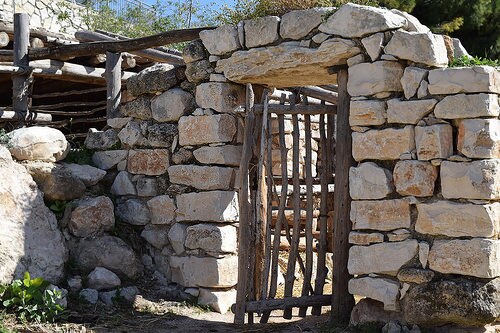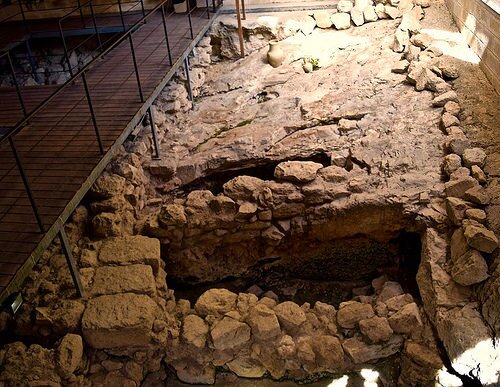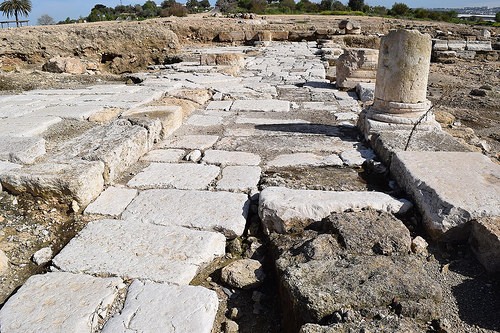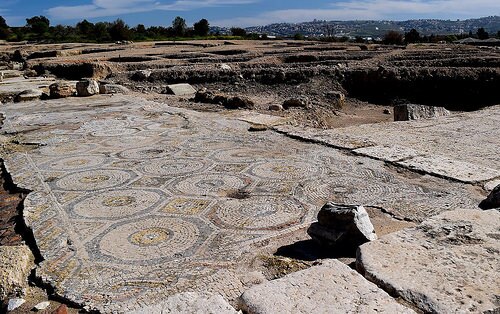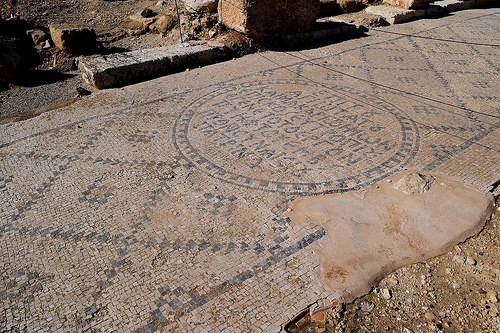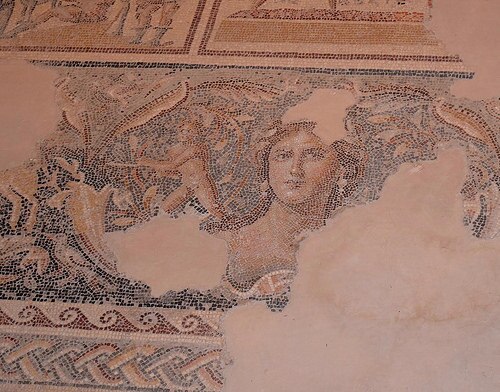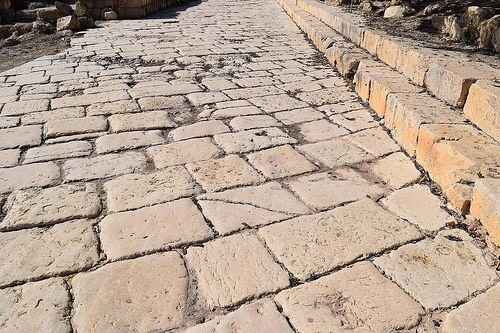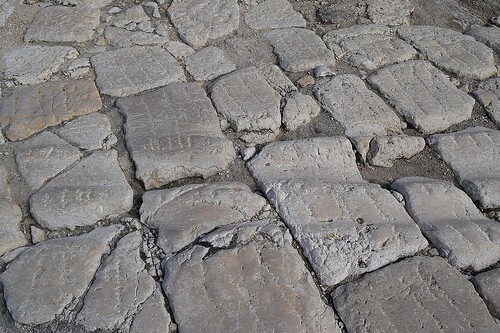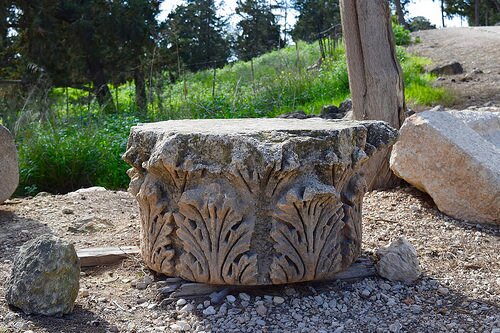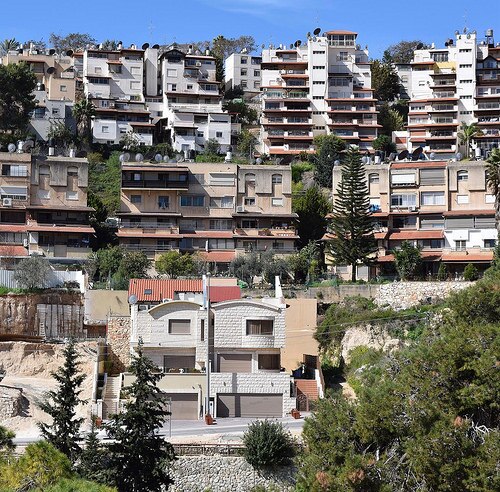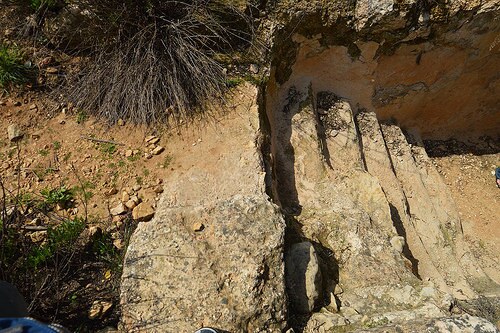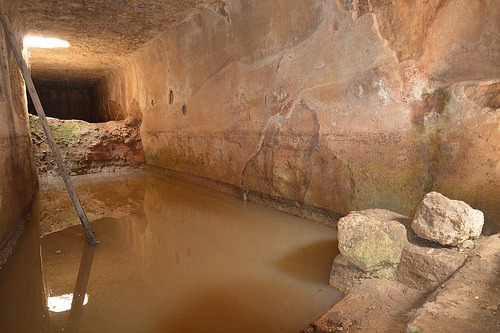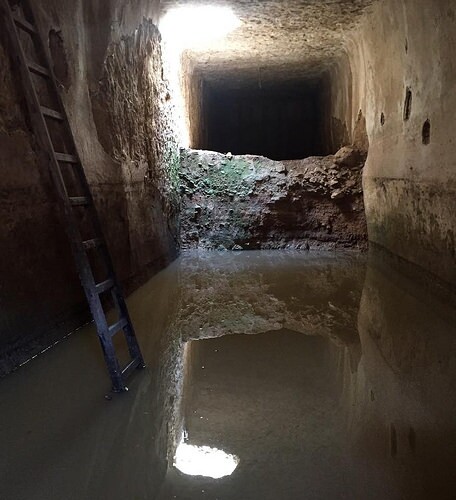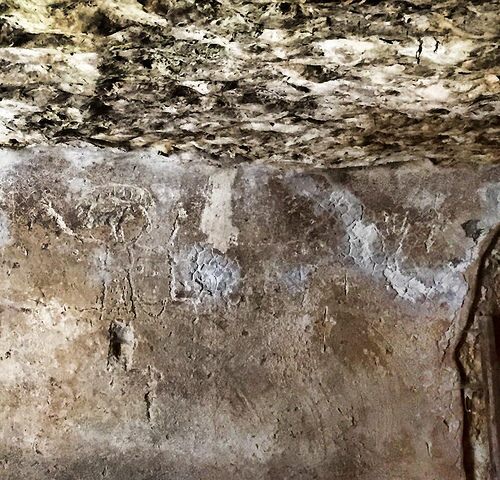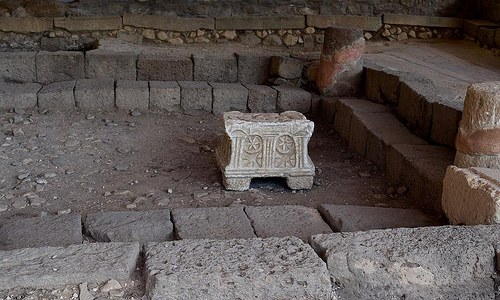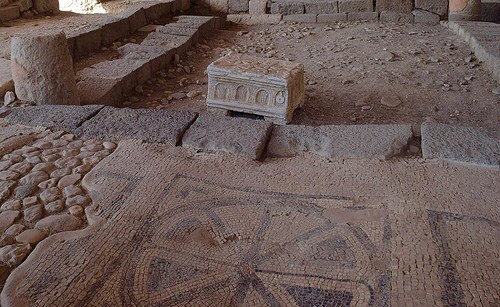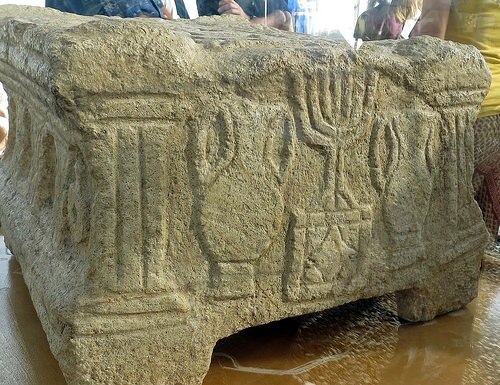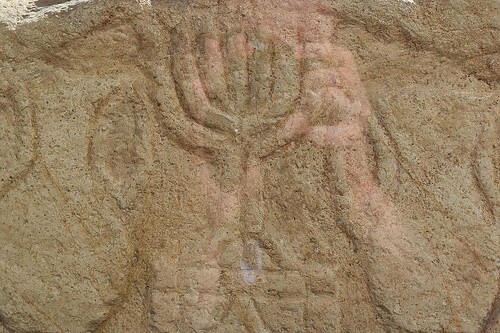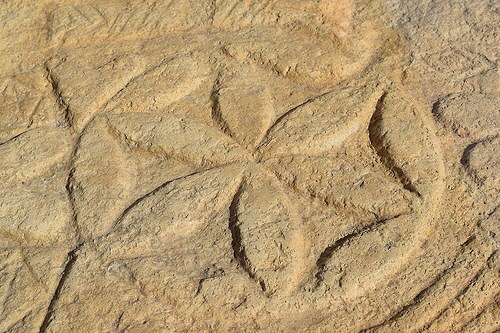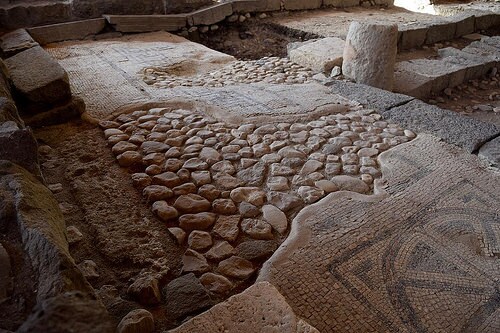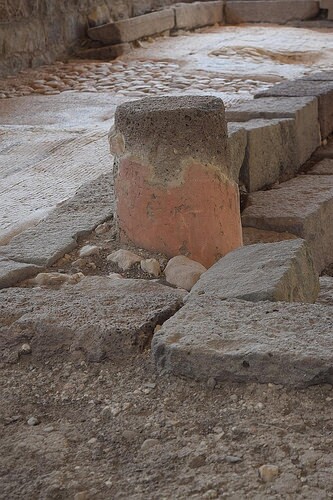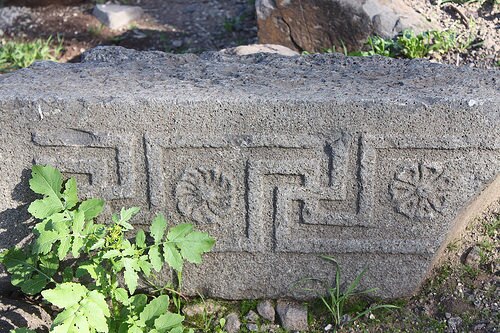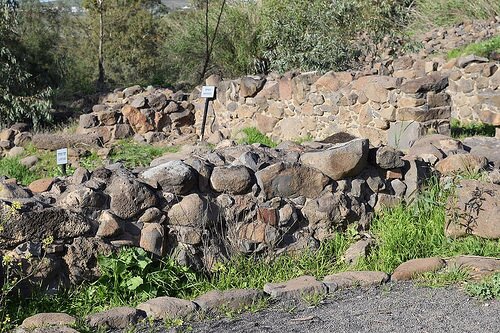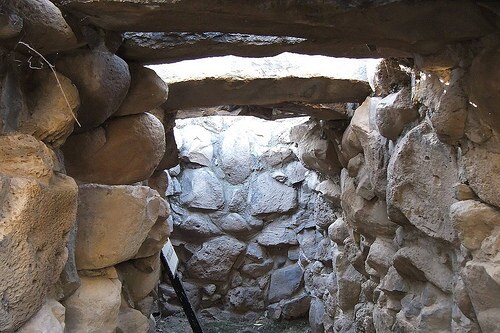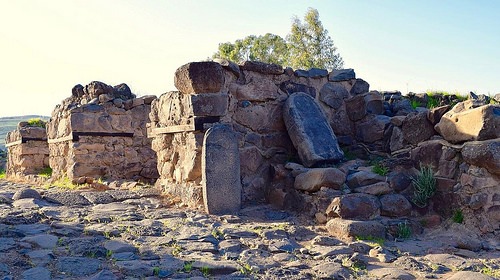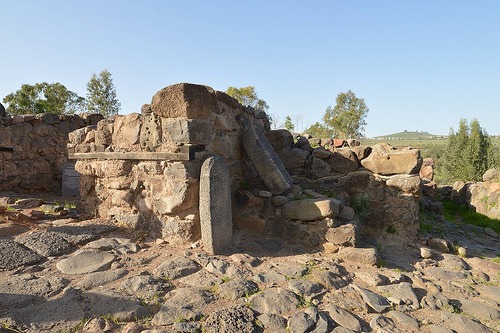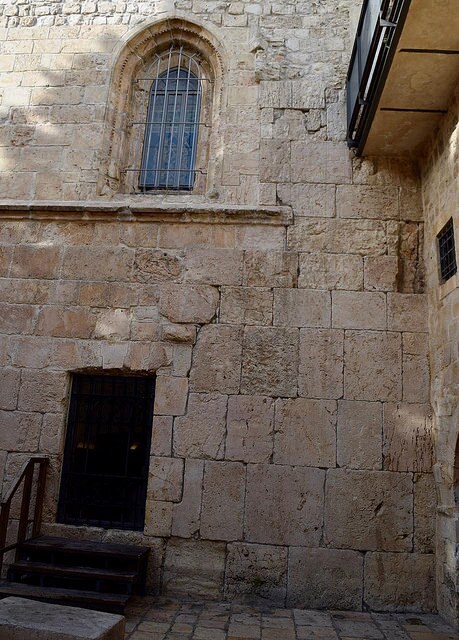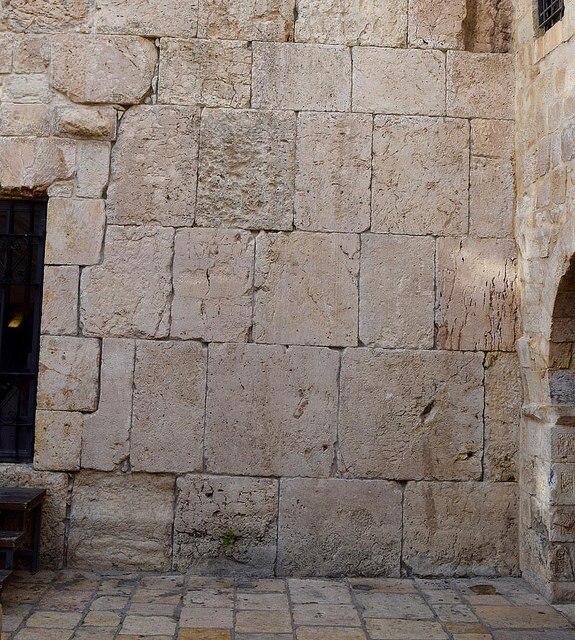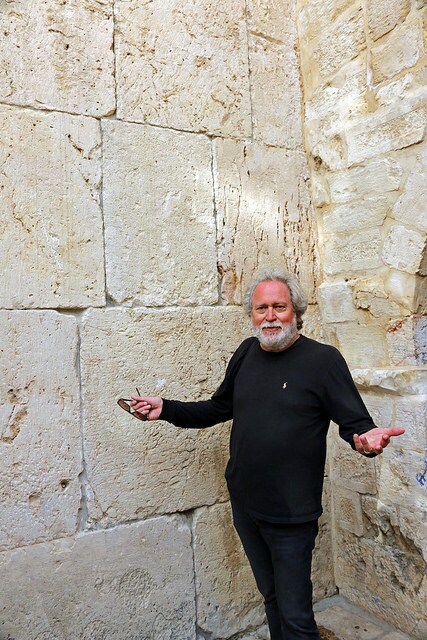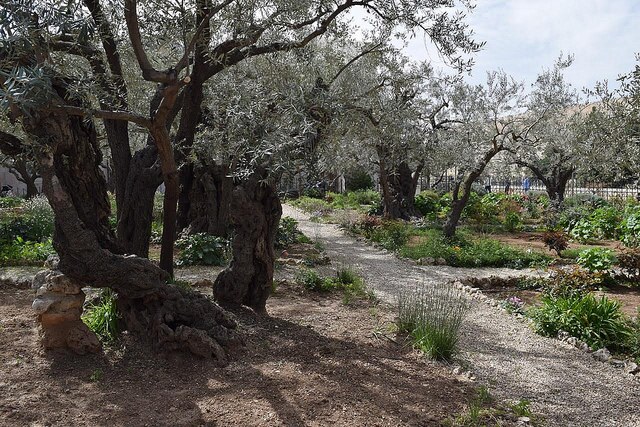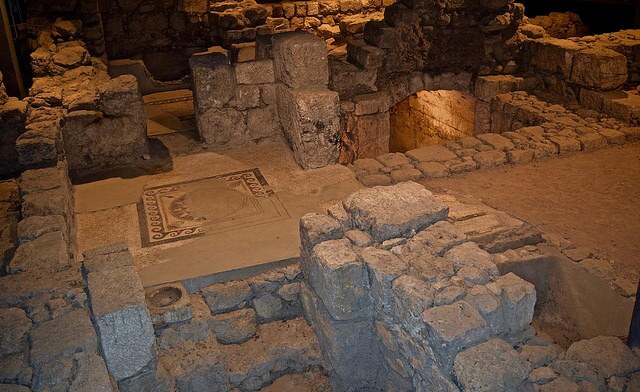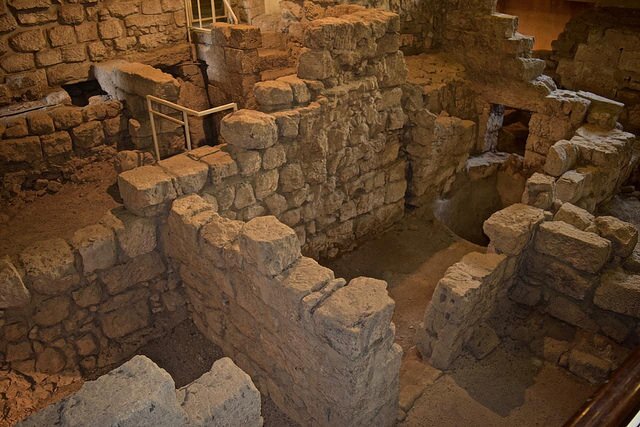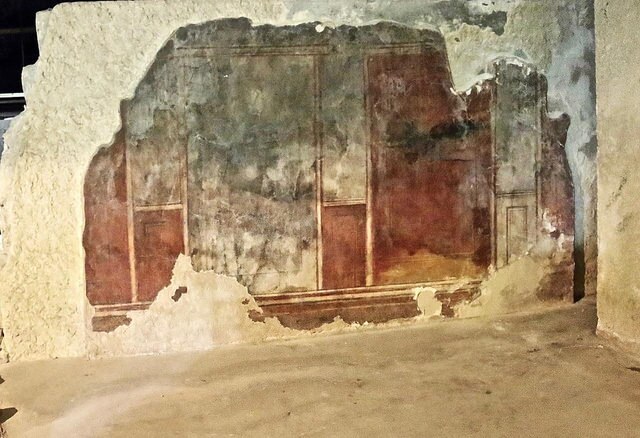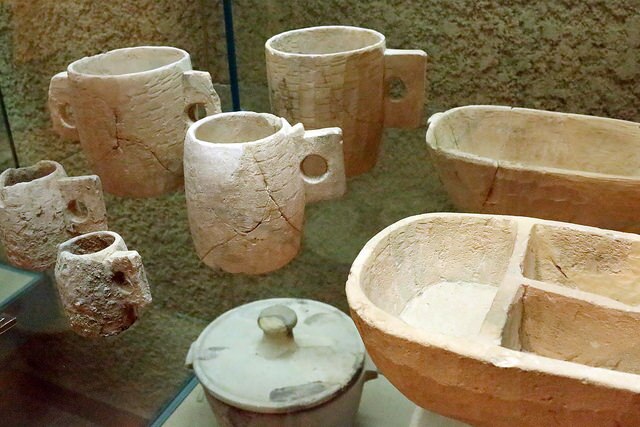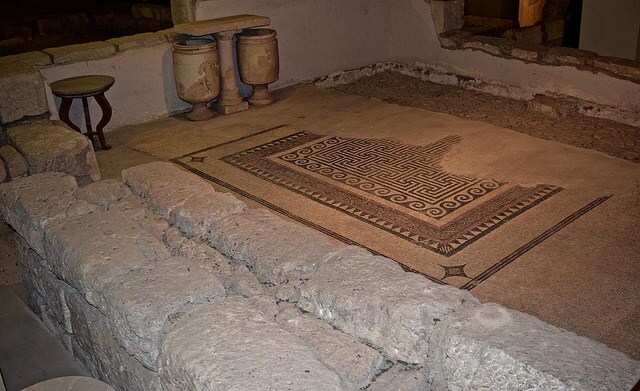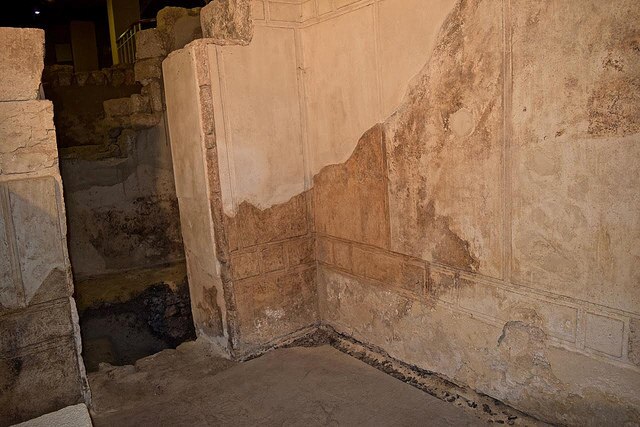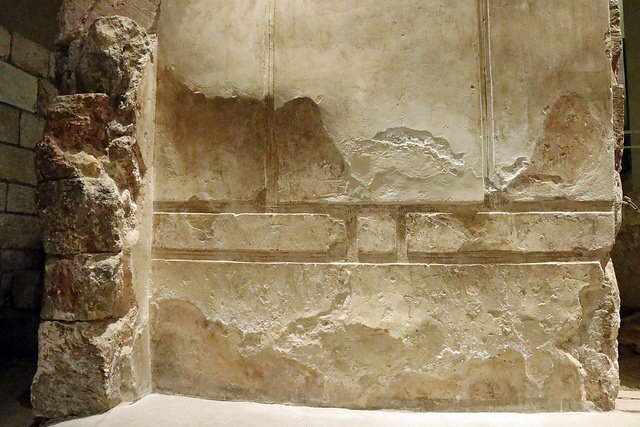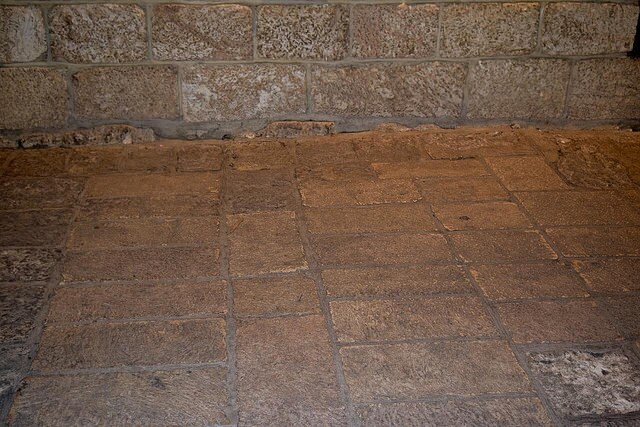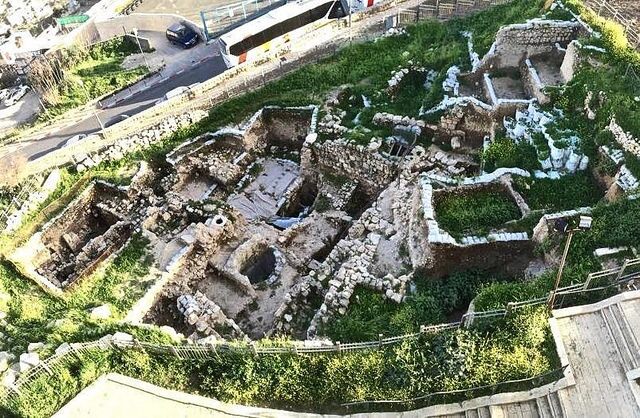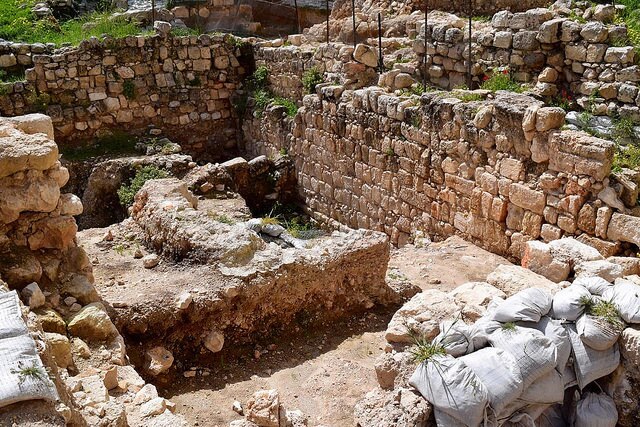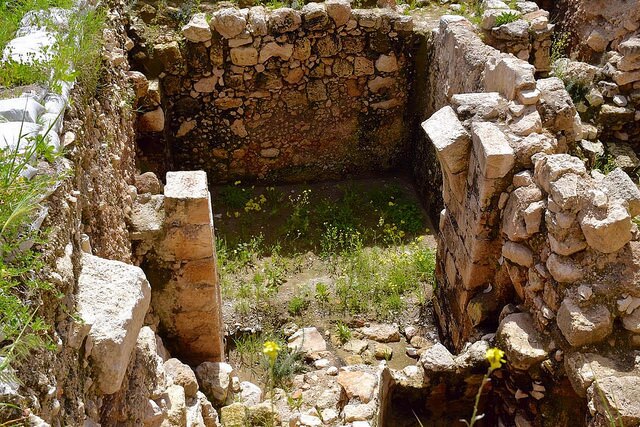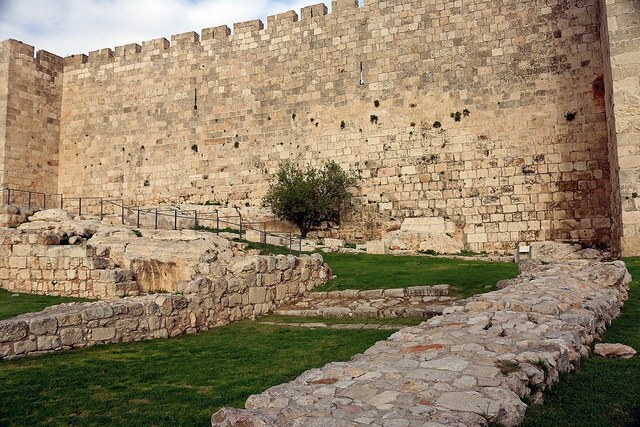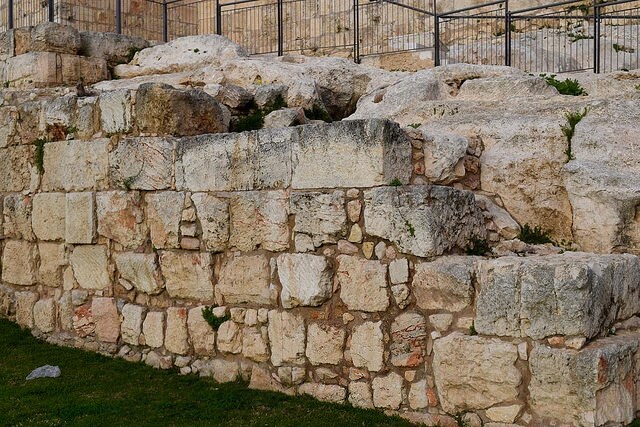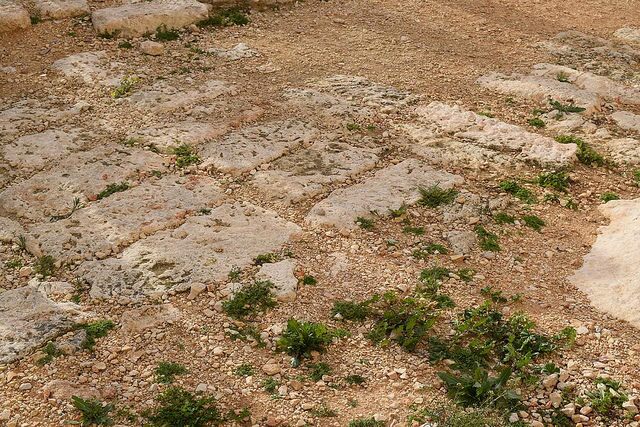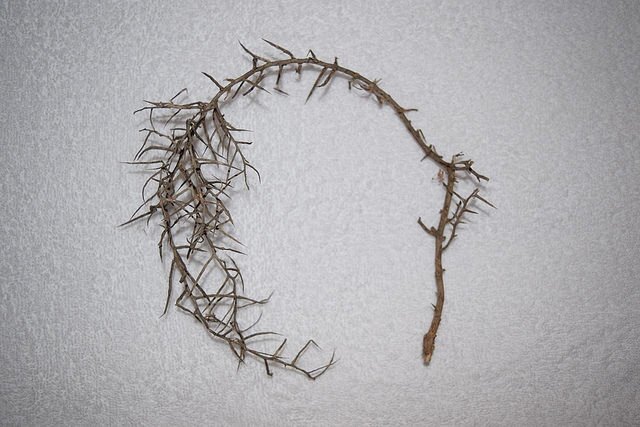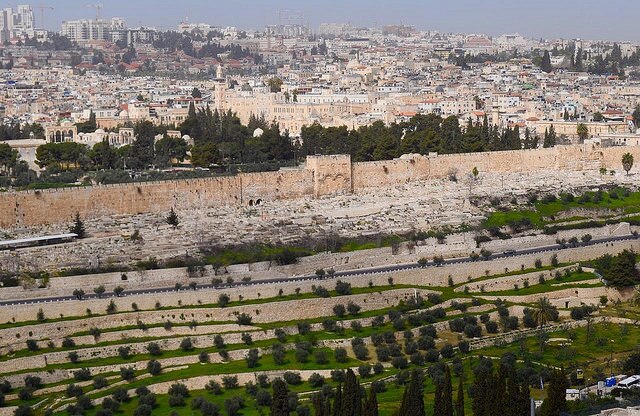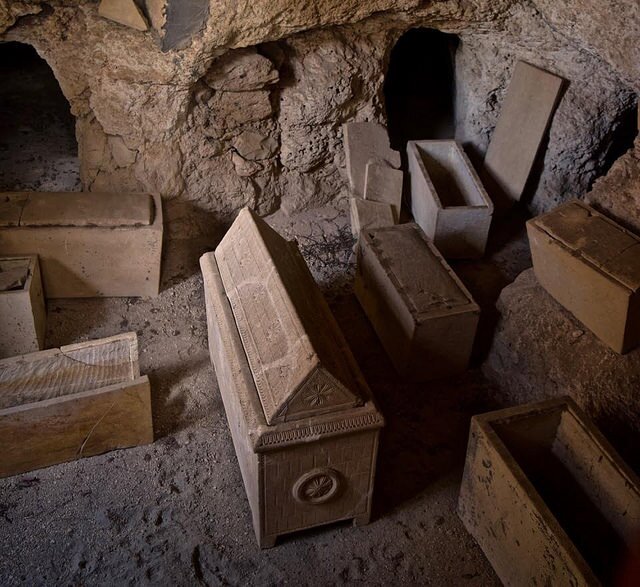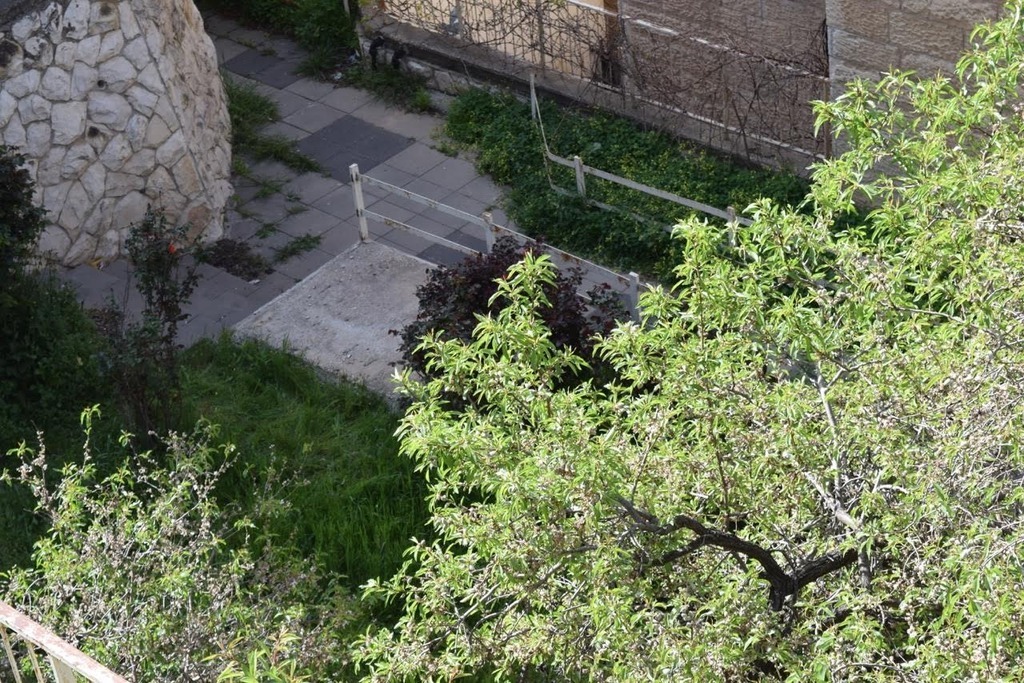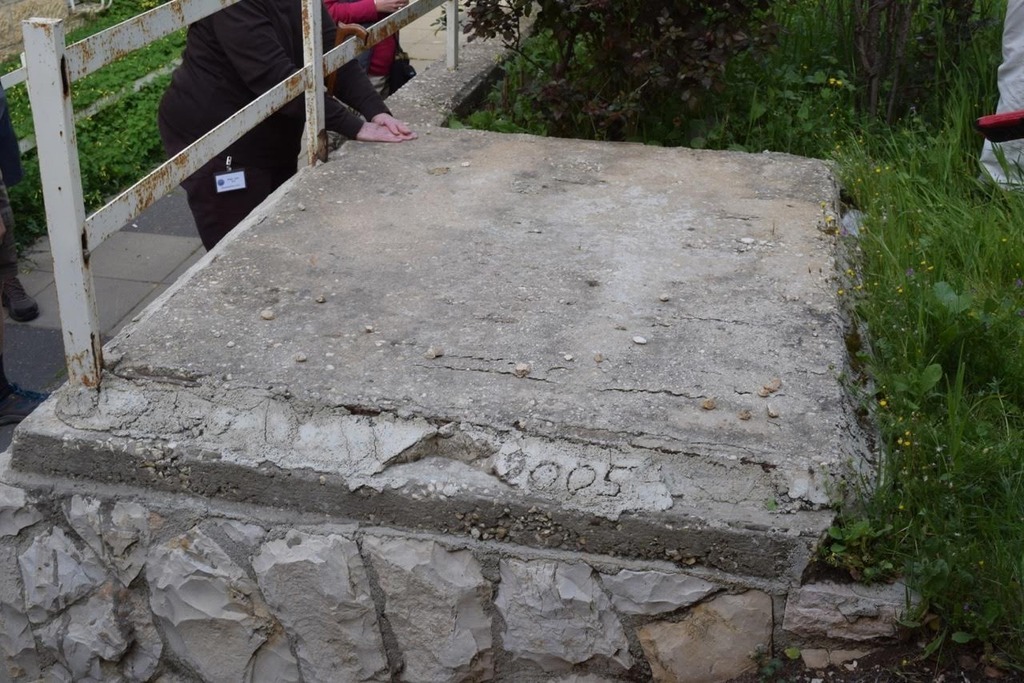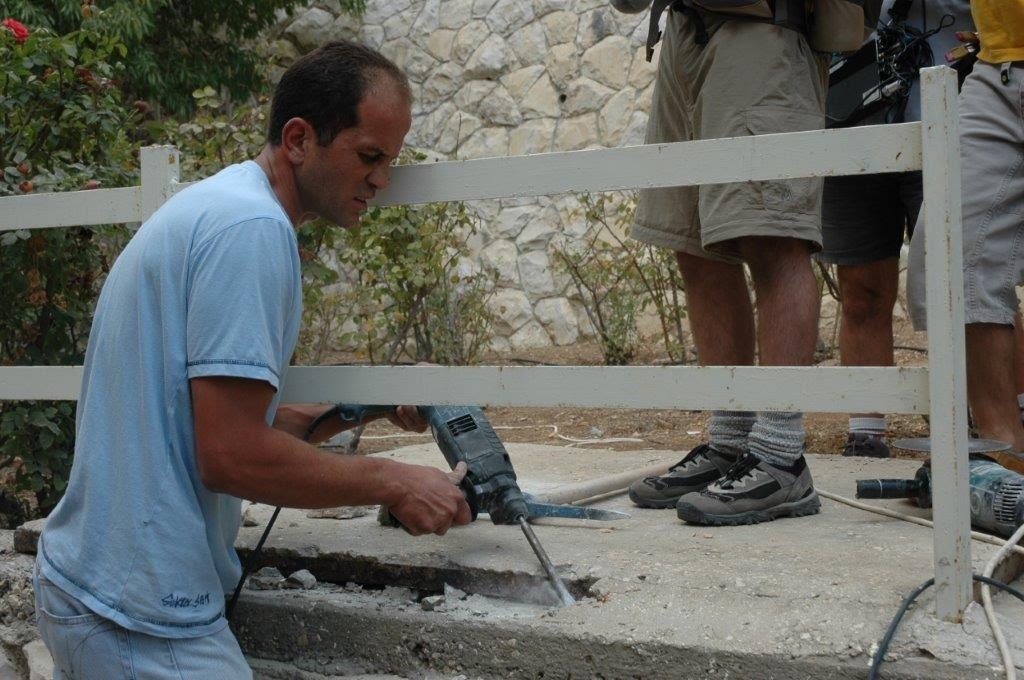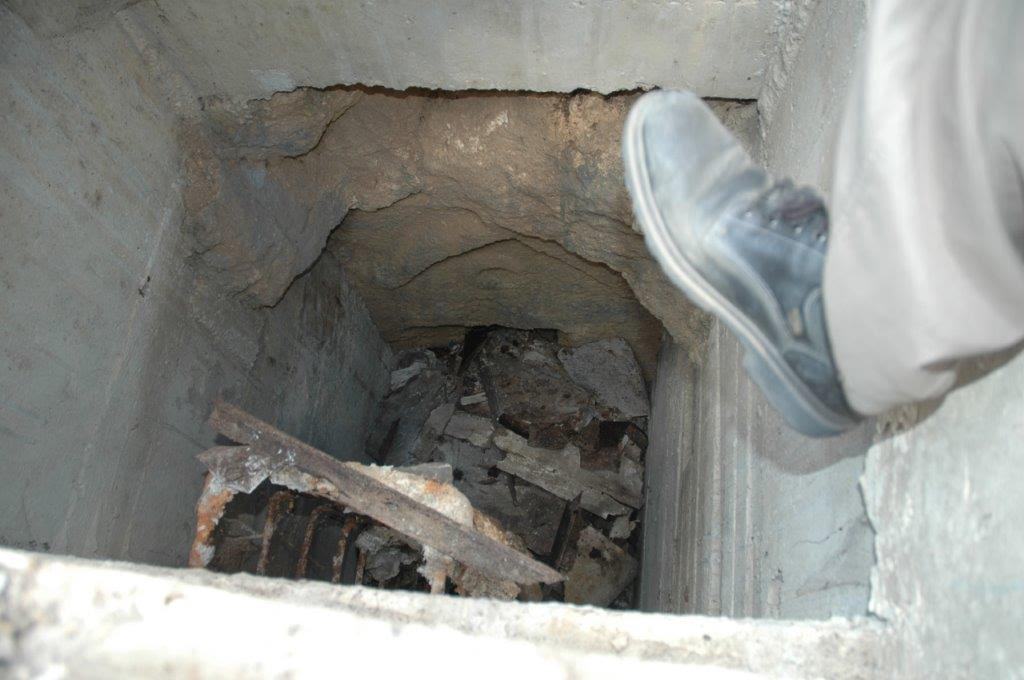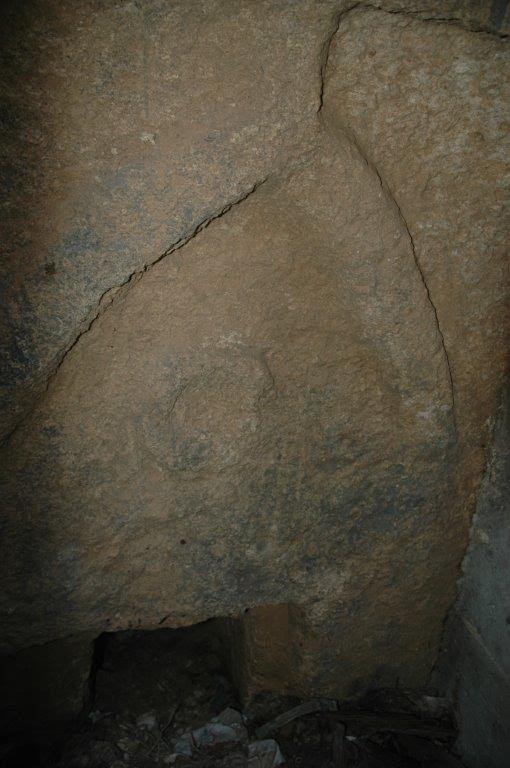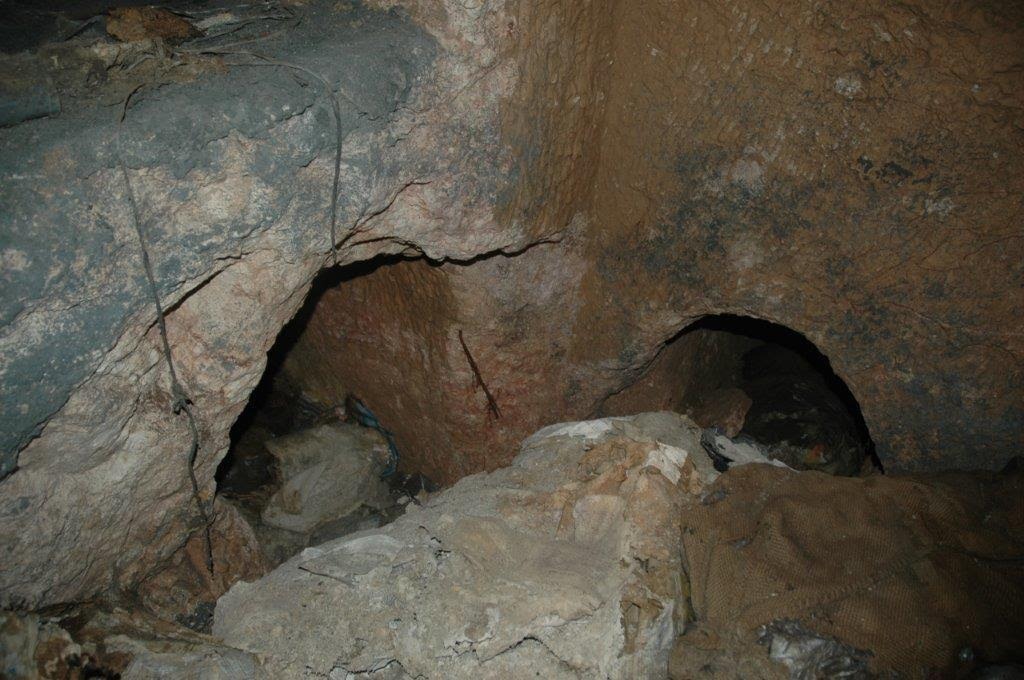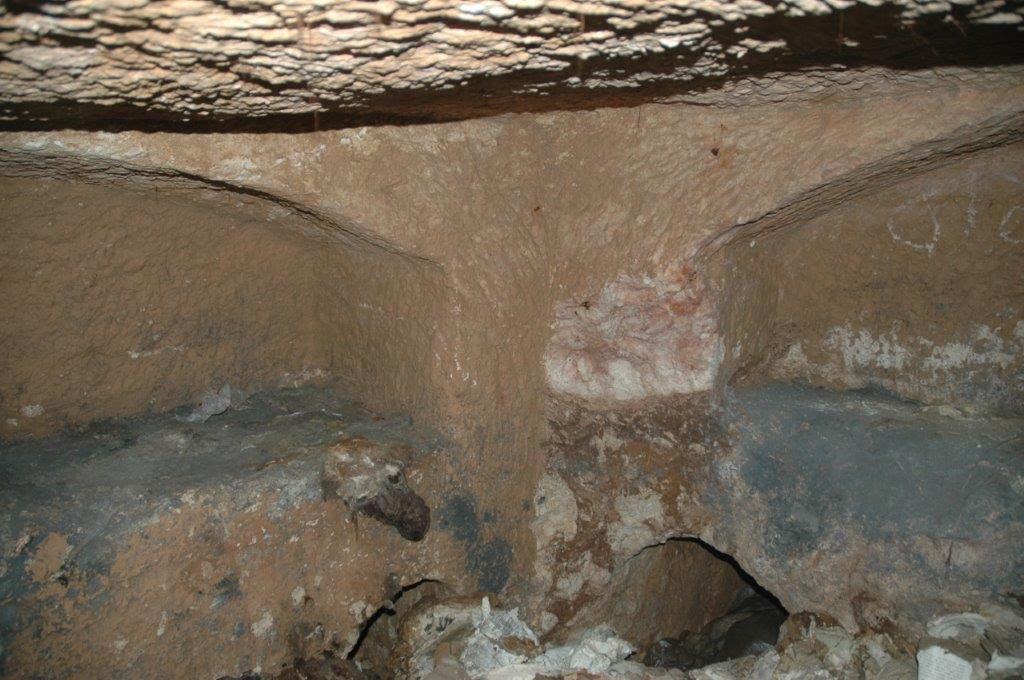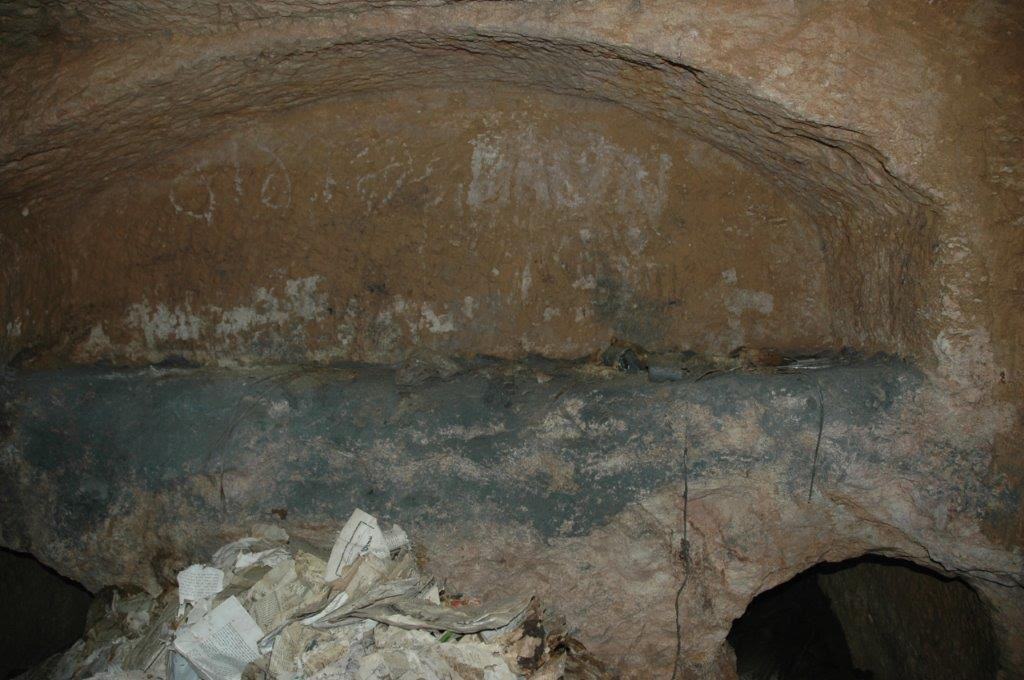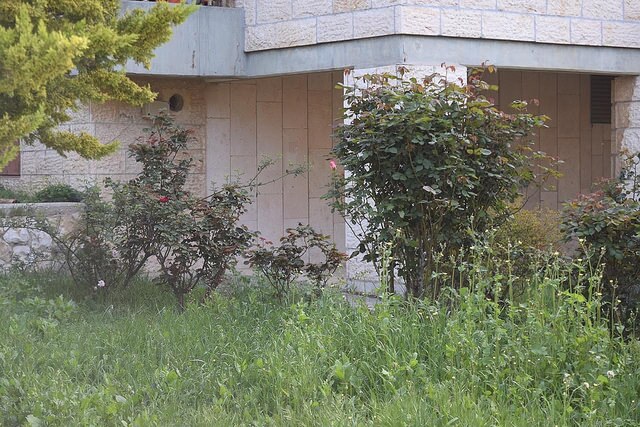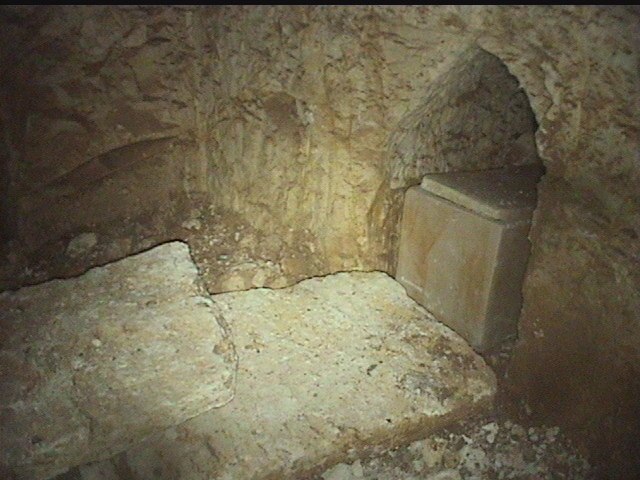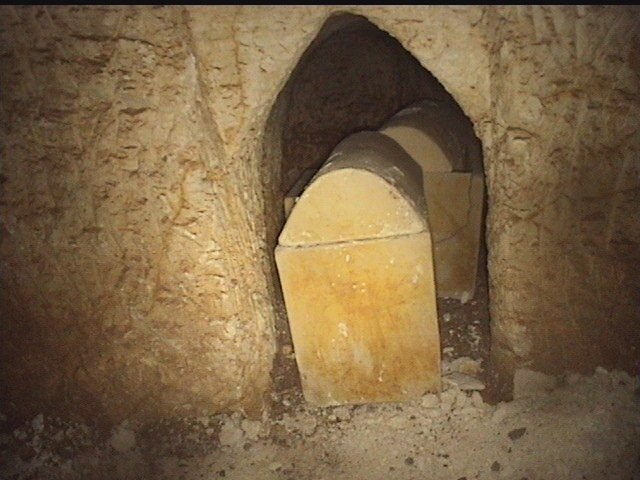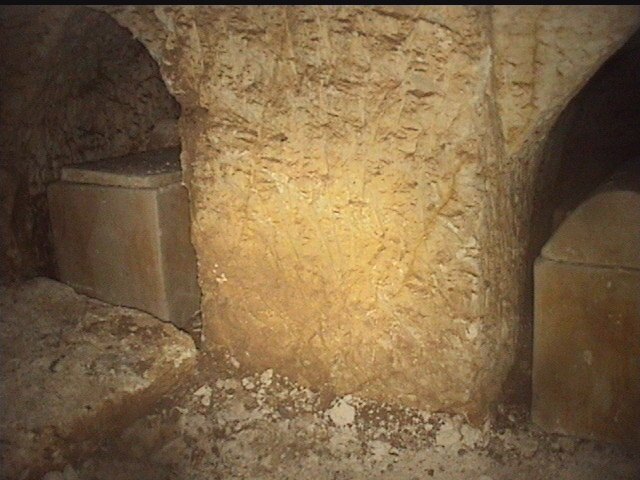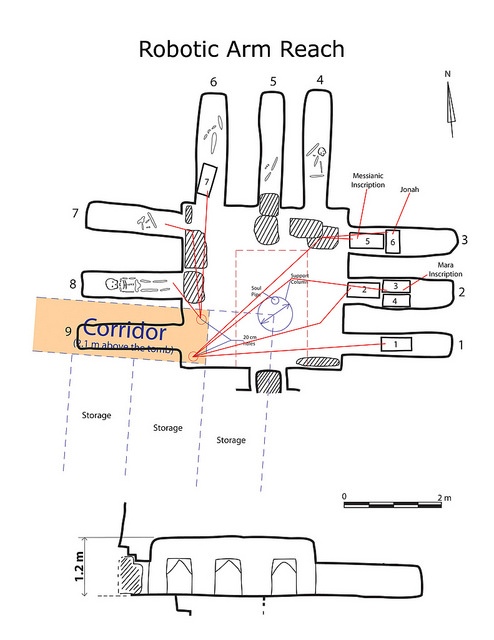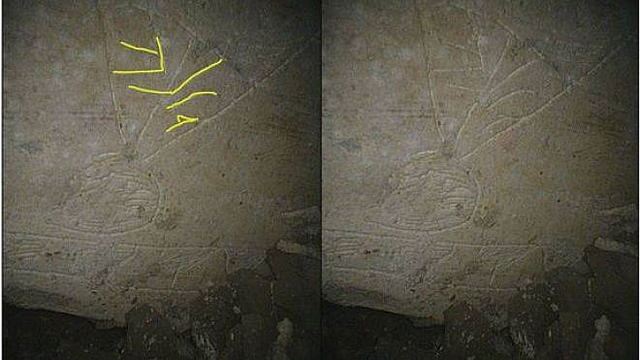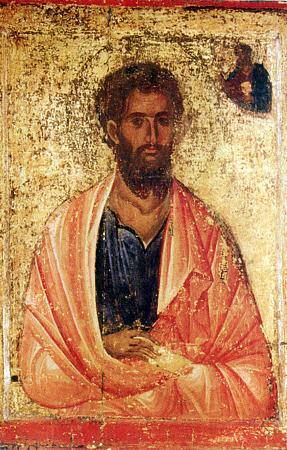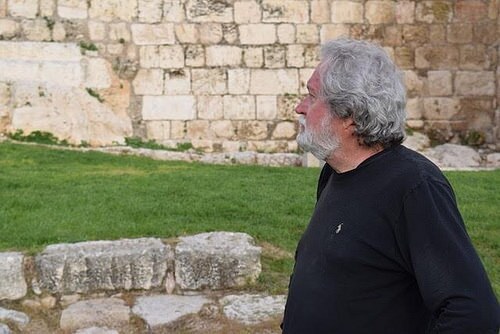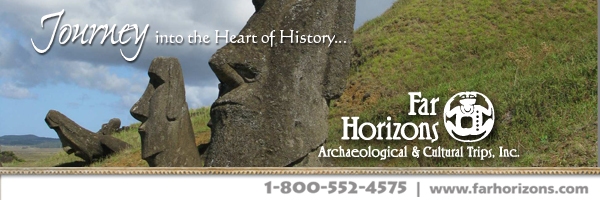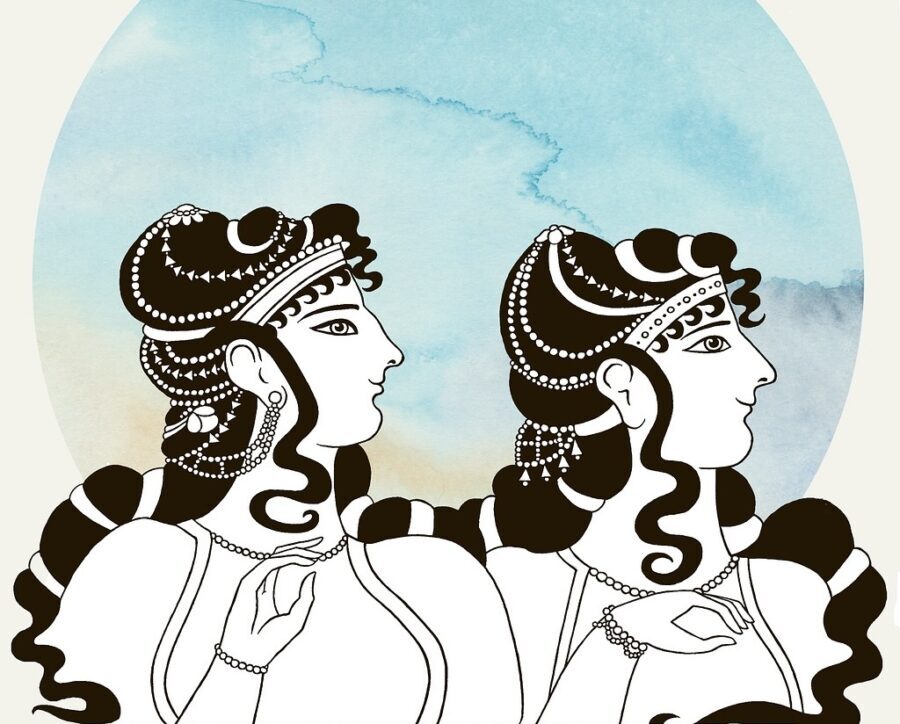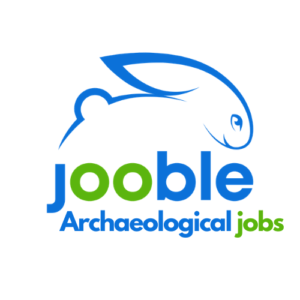
Nestled deep within a quiet residential community of apartments in southern Jerusalem lies a nondescript 5 x 5 square slab of concrete. It rests horizontally atop a small elevated garden plot or terrace of surrounding grass and other plants. To any stranger strolling by this slab, nothing would stand out to catch the eye. There are no decorative adornments. Other than the date ‘2005’ inscribed along its southern edge, there are no inscriptions or markings.
But on one clear morning in early March, 2016, a group of tourists quietly approach and surround the slab with a reverence most might ascribe to a group of friends and family standing before the grave of a lost loved one. Clearly, it means something to them. Some of them place small stones on top of it, long a graveside Jewish tradition for honoring deceased family members and friends, (and a way of letting their deceased loved ones know that they are not forgotten). Some shed tears. Some bow their heads in silent prayer. Some touch it with their hands. Still others snap photographs of the place for memory and posterity, including a journalist traveling with the group. A 70-year-old man with a thick white mane and beard leads the group. Quietly addressing the group, his energy and crisp voice belie his age. But he is not a rabbi or priest. He is Dr. James Tabor, a prominent scholar and historian, professor of Christian origins and ancient Judaism at the University of North Carolina, Charlotte. He is considered one of the world’s foremost authorities on ancient Late Second Temple Judaism and early Christianity. And few others know more than he does about what lies beneath the surface in this place. The slab actually caps an ancient subterranean 1st century C.E. tomb, the excavated contents of which drew media headlines across the world more than 20 years after its initial discovery. For Tabor and others, the find represents the most direct archaeological evidence for the person and life of Jesus, the man who arguably has impacted more lives than any person in human history. For him, this tomb, popularly known as the Jesus Family Tomb, has represented a major milestone in a lifelong quest. But the discovery and his claims have produced a firestorm of scholarly debate and theological uproar like few other archaeological finds in history. More on the tomb discovery story later.
Against the Grain
Though he did not know the gravity and depth of the scholarly journey that lay before him at the time, his personal story really began on a Jerusalem stopover in 1962. His family was returning to the United States after his father, a young Air Force Officer, had completed a tour of duty in Iran. Tabor was 16 years old at the time, but what he learned on that trip planted the seeds of a lifetime quest that has continued to this day.
“Back in 1962 there was precious little one could see in the Old City of Jerusalem that could be reliably connected to our gospel narratives,” writes Tabor in his blog. “Of course there were all the standard holy sites–the garden of Gethsemane, the Via Dolorosa, the Church of the Holy Sepulcher, and the Mt. of Olives, but even at that time I had read enough from the guidebooks to know that many of these places to which the Christian pilgrims flocked had little historical or archaeological basis, despite their devotional attractiveness to millions.”
His new-found passion and quest to find answers found an outlet in his education, eventually leading to his PhD in 1981 at the University of Chicago in New Testament and Early Christian Literature. His studies taught him the rigors of sound historical research, and to this day he is regarded among the world’s most renowned scholars of ancient Second Temple period Judaism and early Christianity. Though Tabor, like many publishing scholars in his field, would likely agree that one must develop a thick skin when it comes to interpreting the documents and archaeological evidence bearing on such sensitive topics as Jesus and his times, surely nothing had fully prepared him for the swirl of controversy that would erupt in reaction to his remarkable findings of recent years. Controversy aside, his story revolves around a portrait of Jesus and early Christianity based on his years of painstaking historical and archaeological research — a portrait that has evolved to differ markedly from the traditional, long-standing perceptions of the man Jesus and the movement he spawned two thousand years ago. The portrait begins, of course, at the beginning of Jesus’ life in his childhood years.
The Tekton’s Son
Frustratingly little, in both historical accounts and the gospel accounts, tells us about the 30 “lost years’ of information in the life of Jesus. Beyond the canonical gospel records, however, there are a few accounts that relate events in Jesus’ years as a youth. Tabor points to the Infancy Gospel of Thomas, for example, which relates a story where Jesus, when five years old, creates 12 sparrows out of mud on the Sabbath. But the Infancy Gospel of Thomas is widely considered a less authentic 2nd to 4th century C.E. writing with more legendary or mythological value than, by comparison, the gospel canons.
Nevertheless, some bits of information can be teased, with careful examination and a reference to the archaeological evidence of the times, from the gospel narratives themselves, particularly as they apply to Jesus’ circumstances as a youth.
The traditional perception as drawn from the gospel writings tells us that Jesus and his family were poor, at least at his birth. Tabor, based on his research, concurs with this view, especially as it is reflected in the Gospel according to Luke, where his family, in fulfillment of the law of sacrifice for the firstborn, sacrificed two doves at the Temple soon after his birth. According to Tabor, this was a clear indication of the young family’s poor economic status, as the law of the Torah required a sacrifice of a lamb as a burnt offering and a dove as a sin offering before the Temple priests. The Torah provided an alternative means for the poor — namely, that the sacrifice of two doves in place of the lamb and the dove would meet the requirements of the law.
Further indications of the family’s economic/social status, according to Tabor, were reflected, for example, in the father and son’s occupation. Passages in the canonical New Testament refer to Jesus in his boyhood as the carpenter or carpenter’s son. To work as a trade laborer of this kind in 1st century CE Roman-occupied Palestine would have been considered one rung above being a slave, according to Tabor. Work in such occupations was hard with comparatively low compensation. A more accurate translation of the ancient text, however, as Tabor states, would be reference to Joseph and Jesus as “builders”, or “tektons” (being the Greek word equivalent) in the 1st century CE Galilee area, an occupation equally regarded. To be a builder in this region during this time period meant working primarily in stone, with perhaps woodworking, or carpentry, skills as a subset. This makes sense as most of the buildings, including residential housing, in the area were built mostly of the local stone. And as Nazareth, Jesus’ family’s place of domicile, was a small village, to make a living Joseph and Jesus likely would have found employment more often in neighboring Sepphoris, the big city, the “ornament of all Galilee” and new capital established by Herod Antipas, where expansive building was surely taking place in the region at the time, based on what is known from the historical and archaeological record. Sepphoris in its day was surrounded by small villages, like Nazareth, that in today’s cultural jargon would have been the equivalent of this city’s suburbs. One could therefore argue that Sepphoris, with its new opportunities for work, was a booming city that saw Jesus’ presence as a youth and builder in the days of his apprenticeship under his father.
Central to village life in every Jewish community in the 1st century C.E. was the local synagogue. There are passages in the biblical account that indicate that Jesus visited synagogues during his campaign or ministry. But as a young observant Jewish boy in the Jewish village of Nazareth, it would be reasonable to suggest that as a youth he would have also performed the obligatory function of attending and performing in the synagogue with his father Joseph. It would have been during this time that Jesus received his religious education, the foundation from which he later launched his campaign as an adult. And in those days the teachings and thoughts of Judaism were remarkably diverse. “How much Jesus spoke and how much he listened in these adult gatherings growing up we have no way of knowing,” writes Tabor in his book, The Jesus Dynasty, “but from a young age he must have begun to absorb the variety of ideas and conflicting opinions that were expressed. Judging from the oral Jewish tradition that eventually was written down in the the Mishnah, as well as from the texts of the Dead Sea Scrolls and evidence in the gospels, the range of topics was [seemingly] endless…….What characterized Jewish life, even peasant Jewish life, was this endless ongoing discussion and debate of the meaning and implications of the stories, commandments, and teachings of the Torah and the Prophets.” Given this, coupled with the messianic movement and spirit that permeated much of Jewish thought and life at this time — which we now know based on historical evidence — it is easy to picture the formative environment that helped to shape the teachings and message that Jesus eventually incorporated into what he professed to be his messianic mission. Today, there is archaeological evidence of only a few 1st century CE synagogues — such as those uncovered at Capernaum, Gamla and Magdala near the coast of the Sea of Galilee and one at King Herod’s fortress of Masada near the Dead Sea. No evidence of a synagogue has yet been recovered archaeologically at Nazareth — but Nazareth today is a bustling city and the remains of much if not all of the original 1st century CE village likely remains almost unreachable beneath the congested, modern urban landscape.
————————————————————————–
Article Supplement 1
The Towns of Jesus’ Boyhood
Ancient Nazareth would have had all of the characteristics of typical small Jewish village life. Based on archaeological and historical research, the houses were modest structures constructed of field stones packed with a mixture of straw and mud, dirt floors and few windows, roofs of thatched reeds over wooden beams that made for flat rooftops which were also used for sleeping and other domestic activities. Larger houses likely had courtyards, accommodating extended families, typical features of such homes. Life was simple, without the fineries of wealth such as mosaics, fine pottery and glassware and bronze vessels. Any livestock would have been kept in enclosures attached to the houses. Meals were simple, consisting of bread, lentils, olives, and some milk, cheese, salted fish, meat, fruits and vegetables as available. Archaeological research has shown from the examination of skeletal remains that dietary deficiencies and death before age forty may not have been uncommon. Trades practiced by the residents were often practiced from spaces in their homes. Speaking of the old Nazareth, says Tabor, “You can think of it as maybe 50 to 100 people — like a family village — perhaps an extended family village.”
__________________________________________
Above and below: House structures reconstructed in Nazareth as they might have appeared during the early 1st century CE. based on archaeological and historical data.
_________________________________________________________
Above: A portion of the excavated remains of a 1st century courtyard house in Nazareth. First uncovered in the 1880’s by members of the Sisters of Nazareth convent, it was investigated later in 2006 by archaeologist Ken Dark and colleagues of the U.K.’s University of Reading. Dark suggests that the possibility that this house could have been the actual boyhood home of Jesus and his family cannot be dismissed.
________________________________________
Above and below: A typical small synagogue in Nazareth—a modern reconstruction showing how it might have appeared during the 1st century CE. Above, the entrance into the synagogue, looking toward the doorway from the inside. Below, a view of the interior of the synagogue looking into the synagogue from the doorway. Archaeologists and biblical historians suggest that such a synagogue in Nazareth was likely frequented by Jesus and his family. Above photo by Lori Woodall; Below photo by Daniela Ciubuc
___________________________________________________
Sepphoris (pictured above), Herod Antipas’ capital of the Galilee, was located only about 3 miles from Nazareth. It is possible that the residents of Nazareth traveled back and forth to Sepphoris, traditionally thought to be Mary’s home town, just as one would do today living in a community or town near a large metropolitan area. Looking at Nazareth and Sepphoris today, however, “it is all reversed”, says Tabor—Nazareth is a bustling modern city. In contrast, with no modern city presence and no residents, Sepphoris is silent and lies mostly hidden beneath the surface, boasting ancient remains of Greco-Roman buildings and other artifacts. Only a 10th of its remains have been excavated and studied by archaeologists thus far. In the 1st century C.E. it was a lively place, the showpiece of Herod Antipas’ Galilee. Tabor suggests the possibility that Jesus, having grown up within sight of Sepphoris, which was set atop a high point relative to Nazareth, may have had Sepphoris in his mind’s eye when he made his statement about being “the light of the world”: “A city that is set on an hill cannot be hid” (Matthew 5: 14). One can imagine seeing its lights from Nazareth and surrounding villages at night during festivals or special celebrations or occasions, like a beacon from the heights.
_______________________________________
Above and below, an example of the beautiful mosaic work found among the excavated ancient remains of Sepphoris, Herod Antipas’ “Jewel of the Galilee”.
________________________________________________________
This depiction of a young woman in the excavated Dionysus House at Sepphoris has been dubbed the “Mona Lisa of the Galilee”, one of the iconic symbols in the popular archaeological literature about Sepphoris.
____________________________________________________
Detail of the ancient Roman road system through Sepphoris. Below, notice the ancient rut marks worn into the road produced by the countless wheeled vehicles that made their way through the city in its heyday.
_______________________________________________________
Remains of an ancient columnar capital, a reminder of the grand Greco-Roman style that Herod Antipas employed to transform and expand the city into his Galilean capital.
__________________________________________
(Above) Today, in contrast to the archaeological remnants of the historically much larger neighboring town of Sepphoris, Nazareth is a large, congested Christian-Arab urban center, a far cry from its existence as a small Jewish community in the 1st century C.E.
————————————————————————-
The Two Messiahs
The standard storyline most often cited about the beginning of Jesus’ ministry as depicted in the gospel accounts portrays Jesus beginning his career with baptism by John the Baptizer, who proclaims the primacy of Jesus’ mission over his:
“I indeed baptize you with water unto repentance: but he that cometh after me is mightier than I, whose shoes I am not worthy to bear………Then cometh Jesus from Galilee to Jordan unto John, to be baptized of him.” (Matthew 3: 11 – 13)
Christendom proclaims John as a preparatory prophet, who, according to the words of the ancient prophets, was to emerge as the foreseen Elias, making way for the time when Jesus would essentially take over as the Messiah — “he must increase and I must decrease” (John 3:30).
But Tabor argues for a different scenario, drawing from his years of research of ancient writings, such as the lost, reconstructed gospel “Q”, an earlier source document predating the time when the canonized gospels were written (though “Q” has not been immune to scholarly dispute). The clues to Q were found 150 years ago by scholars through deductive analysis of the known canonized gospels. From this and other sources, Tabor suggests that there were actually two equally important Jewish messiahs operating concurrently — John and Jesus, working in partnership — Jesus himself indicating the primal significance of his cousin John: “What did you go out into the wilderness to see? A prophet? Yes, I tell you more than a prophet……I tell you among those born of women none is greater than John.” (Luke 7: 26 – 28)
Moreover, Tabor suggests that Jesus was first a follower of John, who already had an entourage of apostles (some of whom later joined Jesus), later working in equal partnership with John, and then succeeding John upon his death at the hands of Herod Antipas.
“Jesus and John become full partners in the work to which they believed they were jointly called,” writes Tabor in his book, The Jesus Dynasty, “but Jesus’ deference to John is unmistakable in our sources once the veil of [later] Christian theology is removed……….It is no accident that the following year of A.D. 27 [the year after Jesus’ baptism] is largely blank in our records. That was the year of the joint work of the Two Messiahs — now lost to Christian history and memory.”
“Understanding Jesus,” Tabor thus asserts, “begins with recovering the historical John the Baptizer.”
———————————————————————-
Article Supplement 2
The Cave of John the Baptist
Tabor calls it “one of the greatest archaeological discoveries of the last 25 years”. Located near the Tzuba kibbutz just west of Jerusalem in the Judean hills, an ancient cave was discovered by archaeologists in 1999. Otherwise popularly known as the Suba Cave, it is located near a vineyard within walking distance of Ein Karem, the small town or village long traditionally considered to have been the birthplace and home of John the Baptist and his family.
It all began when Shimon Gibson, a well-known British-born Israeli archaeologist, was first contacted in 1999 about carvings or engravings discovered in a cave near Tzuba and Ein Karem. After his initial investigation of the cave, he called Tabor, by then known as a scholarly expert on John the Baptist.
“I remember I was sitting in my office when he called,” said Tabor. “At first, I didn’t believe it.”
Gibson suggested that the location, the drawings/engravings, and other circumstantial elements pointed to the possibility of some association with John the Baptist. Following examination of photos of the cave drawings sent by Gibson, Tabor knew there was something to this discovery beyond a simple hunch. He, along with Gibson, quickly assembled an excavation team and, very early on, unearthed something that had exceeded all expectations.
“I’ll never forget that day,” said Tabor, as he related the story of the day they really hit “pay dirt”. In the beginning, the cave, having silted up through centuries, allowed only about one meter’s worth of clearance from the roof of the cave to ‘ground level’ in order to enter. “We had to crawl on our hands and knees,” said Tabor. But on the last day of the excavation season in March of 2000, the excavators began to encounter Roman period pottery shards.
“As we dug down we suddenly came across a meter to a meter and a half filled with clearly 1st century C.E. period pottery shards, and this was out of a total of 4 meters of cultural layers in the cave. So something was really going on in this cave during the early 1st century. We found evidence of thousands of clay vessels in the cave, all broken.”
Successive seasons uncovered a large, plastered cave carved out of bedrock with steps leading into a large interior pool of water. The cave extended 90 feet into the hillside bedrock. Gibson and Tabor suggest that it was a place for ritual immersion, or baptism. In the 1st century C.E. such a feature was normally characterized as a mikveh, a Jewish ritual bath, ancient examples of which can be found throughout Israel at a variety of archaeological sites. The Suba Cave is now considered to be the largest mikveh in Israel.
Given the abundance and concentration of the vessels — what was determined to have been small one-handled jugs — the archaeologists concluded that they had to have been deliberately broken and deposited in a relatively short time period.
What was happening in this place?
Tabor and Gibson hypothesize that the pottery shards were related to a baptismal ritual conducted in the cave. Based in part on their research of 2nd century manuscripts, they suggest that baptisms at the time of Jesus and John may have followed a set process that included not only dipping, or immersion, in the water, but also the pouring of water over the head from the vessel, the anointing of the right foot (there is a foot-shaped cavity carved out of the bedrock near the steps no far from inside the cave entrance and just above the water line), and the deliberate breaking of the vessel so the vessel could no longer be used for common purposes. The thousands of 1st century jug shards uncovered in the cave were the remains of these vessels.
Was this in fact a cave used by John to baptize people during the time of Jesus? A cave with drawings or engravings that could be interpreted as a pictographic or visual representation of John the Baptist, located very near Ein Karem, the home town of John and his family, with evidence of use as a facility for ritual immersion — all point to this possibility, according to the site excavators.
But it should be noted that the Suba Cave was initially created and used for a very different purpose. The plaster lining the interior walls of the cave was radiocarbon dated to the Iron Age, and more specifically, to the time of King Hezekiah of Judah. Five years of excavation and research revealed that the cave, including associated exterior features, was actually initially created and used as a clay-making facility for the manufacture of pottery. The cave was first meant to be “a water reservoir [fed by an adjacent spring, which still exists] for clay making,” says Tabor. “Pottery for the king’s house was made at Tzuba because the clay was so pure. Then it went out of use in the 2nd century B.C. and silted over.” It was then re-dug and converted into a ritual immersion facility during the 1st century C.E.
___________________________________
The Suba Cave entrance, looking toward it from outside the cave. Photo by Victoria Brogdon
________________________________________________________
Steps leading down to the Suba Cave entrance. Photo by Daniela Ciubuc
________________________________________________________
Looking into the Suba Cave from the interior steps, which descend into the water as is typically characteristic of an ancient mikveh. The interior of the cave is covered in plaster, which has been present since first applied by the ancients during the days of Hezekiah, King of Judah, when it was initially used as a clay-making facility for pottery-making. The water, though it appears murky, is surprisingly clean in terms of bacterial content. Above photo by Daniela Ciubuc; Below photo by Victoria Brogdon
__________________________________________
______________________________________________________
Rough engraved dawings high on the interior wall of the cave, above the water. Note the figure of a person on the left. Site investigators have interpreted this as an individual, perhaps even John the Baptist, officiating a ritual activity, such as a baptismal rite. Photo by Victoria Brogdon
——————————————————————–
King of the Jews
Central to the message of worldwide Christianity is the proclamation that Jesus was, quite literally, the physical and spiritual offspring of God Himself — or the Son of God, as most Christians would phrase it. As such, Jesus, as the heavenly Christ or Savior of the world as described and promoted in generally accepted Christian theology, embodied the atoning intercession through the crucifixion to save all mankind from the consequences of justice in the form of spiritual and physical death required for transgressing the commandments of God.
Tabor suggests a differing image of Jesus, however — an image that some of his critics, particularly ecclesiastical traditionalists, have disputed. But Tabor hoes the road of rigorous historical research. He believes greater accuracy about the man Jesus can likely be found with a careful and in-depth historical examination of the messianic concept as reflected in the broad array of ancient documents and literature, from the standardized canon to newly-found ancient writings discovered within recent years. These sources prophesy or tell of a Jewish messiah more akin to a Davidic king (by lineage) who, with God’s omnipotent intercession, would rule over Israel on the throne of David; overthrow the foreign rulers in Israel; gather the lost tribes of Israel; and rule the world in righteousness — establishing, literally, the Kingdom of God on earth. But Jesus as Christ the Son of God and all that comes with that, he argues, was an image that evolved beginning with the vision and teachings of Paul and eventually embraced, sanctioned and promoted by the authorities in Rome and other centers, becoming what is today the predominant portrait of Jesus among Christian adherents.
“I am convinced that Jesus most likely began to read certain passages of the Hebrew Scriptures and apply them directly to himself,” writes Tabor in the Jesus Dynasty. “As I see things, this factor is absolutely vital for understanding his developing sense of messianic self-identity.” Those passages described a priestly messiah (as embodied in John the Baptizer, according to Tabor) and a Davidic kingly messiah (Jesus).
With this, Jesus began putting together a provisional ‘government’ through his council of 12 apostles (each to rule over a tribe of Israel), and began his campaign by bringing the message first to the Jews. Unlike the more militaristic movement of the Zealots, this new kingdom would replace the current oppressive order through divine, eschatological Godly intervention, not the human-wielding sword. As Jesus and his entourage began to gather a substantial following among the people, working his miracles and teaching his message with his proclaimed mandate from providence and claim to Davidic genealogy, it was no wonder that the ruling authorities of the time, both ecclesiastical (i.e., the chief priests of the Sanhedrin) and secular (the Herods — Herod Antipas already having been declared ‘King of the Jews’ by the Roman emperor — and Roman authority and order as embodied in the appointed prefect Pontius Pilate), saw Jesus as a potential threat, especially if the movement continued to gain momentum. The stage was being set for accusations of sedition from the ruling authorities, and heresy from the ecclesiastical.
——————————————————————————-
Article Supplement 3
Magdala
Although scholars know from the historical sources that synagogues existed throughout Jewish communities in the 1st century C.E., there are to date only a few such synagogues that have been discovered or excavated by archaeologists. From the biblical record, we know that Jesus visited and taught in synagogues throughout the areas where he conducted his campaign, or ministry. One prominent synagogue has been found near the northern shore of the Sea of Galilee at Capernaum, the town that is known to be the ‘headquarters’ of Jesus’ operations. Although the structure most visible and impressive at the site is a Byzantine-era synagogue, archaeologists have uncovered evidence of the original 1st century synagogue resting beneath the foundations of the Byzantine structure, and a trace of these remains is visible to visitors. Another 1st century structure has been recently excavated and investigated by the Israel Antiquities Authority at Magdala (or Migdal, meaning ‘tower’), the traditional home town of Mary Magdalene, on the western shore of the Sea of Galilee.
The first excavations at Magdala were carried out in the early twentieth century, and again in 2002 and 2006. But the most spectacular finds were unearthed in 2009 when excavators came across the remains of a 1st century synagogue only 30 cm beneath the surface during what was a salvage excavation related to construction of a pilgrimage and holiday visitor complex. Led by Dina Avshalom-Gorni and Arfan Najar of the Israel Antiquities Authority, they eventually uncovered (among other things) the well-preserved remains of an entrance hall/study room, a chamber for storing Torah scrolls, and a large decorated stone, now popularly known as the ‘Magdala Stone’, in the center of the structure. The decorated stone, interpreted as a prayer table or altar, was particularly significant in that it featured clear images of objects or symbols associated with the time of the Second Temple, the great temple that stood during the time of Herodian rule. These images included a seven-branch menorah, rosette, and fiery wheels. The menorah image is thought to be the oldest known depiction of the menorah, at least outside of Jerusalem, as it appeared in the Temple. “We can assume that the engraving which appears on the stone, which the Antiquities Authority uncovered, was done by an artist who saw the seven-branched menorah with his own eyes in the Temple in Jerusalem,” commented Avshalom-Gorni to the Jerusalem Post*. Finds uncovered within the synagogue remains, including a coin minted in Tiberias in 29 CE, helped to date the structure to the first century CE, the time of Jesus’ ministry. Given the Christian New Testament references to Jesus visiting synagogues throughout the Galilee region, archaeologists suggest that the synagogue was likely a place where Jesus taught. Given the dating, the synagogue is thus also believed to have been in use when Josephus commanded rebel forces against the Romans during the First Jewish Revolt.
Moreover, Magdala takes on special significance not only because it was a place that Jesus may likely have visited and taught, but because of its identification with Mary Magdalene. “It’s not absolutely certain that Mary Magdalene was from Magdala,” says Tabor. But he says that he favors the identification.
The synagogue is not the end of the work at Magdala. In addition to the synagogue, decorated stone, and mikva’ot, archaeologists have uncovered evidence of a marketplace with an advanced plumbing system, a central paved street, and a wharf. With the exception of the recent and ongoing construction work related to the Catholic pilgrimage and holiday center, “nothing has ever been built on top of this [place] for 2,000 years,” says Tabor. “This was a major town according to Josephus.” Tabor describes Magdala as an important center for processing and exporting fish products, some of which were exported as far as the tables of the Roman elite in Rome. “It had a significant port, a tower, and a Greco-Roman theater,” he added. “There is a lot more that can be uncovered here.” Excavation work continues.
_________________________________________
Above and below: The Magdala synagogue showing a replica of the ‘Magdala Stone’ in situ, where it was discovered. Note the adjacent floor mosaic work in the foreground of the image below.
___________________________________________________________
Detailed view of a replica of the ‘Magdala Stone’ on display near the synagogue site. Photo by Victoria Brogdon
__________________________________________
Detail view of the menorah image that was inscribed into the ‘Magdala Stone’.
_________________________________________________________
Detail view of the rosette image that was inscribed into the ‘Magdala Stone’.
__________________________________________________________
Images below: Though centuries of time and history reduced the 1st century synagogue to ruins, many of its features remained preserved in remarkable condition, as revealed by the excavations.
—————————————————–
Article Supplement 4
Bethsaida
Thought to be the birthplace of the apostles Peter, Andrew and Phillip, Bethsaida (‘House of the Fisherman’) was an active fishing community during the time of Jesus, and was raised to the status of a Greek city in 30 CE by Philip, the son of Herod the Great. He renamed it Julias, after Livia-Julia, the wife of Emperor Augustus. Here, Philip was buried, according to the historical account of Josephus Flavius. And here, or in the area, based on the Biblical account, Jesus performed miracles, such as healing a blind man and the feeding of the multitude. Like Capernaum and Jerusalem, it is one of the most frequently mentioned locations in the New Testament.
For centuries, the location and remains of the Bethsaida of the time of Jesus and Josephus had been a mystery. For the last 2,000 years, pilgrims had searched the northern coasts of the Galilee to no avail. Unlike places like Capernaum and Tiberias, there appeared to be no commonly acceptable and clearly identifiable trace of it anywhere on the landscape, at least insofar as any reliable historical documentation or tradition could attest. Interpretation of the Biblical geography and references could perhaps provide some clues, which scholars used historically as part of the basis of their search for the lost city.
Then, in 1938, American Biblical scholar Edward Robinson, while exploring the northeastern region adjacent to the lake, discovered a promising tel (a mound containing archaeological remains of a settlement). This tel, he maintained, could be what is left of Bethsaida. It was located approximately 1.5 – 2 km from the lake’s northeastern shore and just east of the Jordan river. Not a likely spot for a fishing village, maintained the critics. But later geological studies showed that the lake was actually significantly closer to the tel 2,000 years ago. Tectonic rifting, sedimentation of the Jordan Delta, and greater usage of the lake water over time through land irrigation and increased population are all cited as possible explanations for the difference.
Finally, in 1987 Israeli archaeologist Rami Arav conducted a ten-day probe of this 21-acre site, then known as et-Tell (“the mound”), on the educated hunch that the site could well be Bethsaida. His preliminary conclusions were positive, but much more needed to be done before the site could be placed on the map as a viable candidate. In 1990, he and a number of colleagues created the Consortium of the Bethsaida Excavations Project, an institutional grouping dedicated to exploring the site, researching and analyzing the remains, and disseminating the findings to academic audiences and the public. Today it numbers at least ten institutions, headquartered in the International Studies and Programs department at the University of Nebraska at Omaha.
Early excavations at the site did indeed reveal a settlement location that had been occupied in Roman times. Salient finds included evidence of a Roman temple dated to the early 1st century CE, including foundation remains, some limestone ashlars and decorated architectural elements. Ritual vessels, such as two well-preserved bronze incense shovels found within the temple footprint, support its description as a temple. It may have been the temple built by Herod Philip in honor of Julia Livia. In addition, courtyard-style houses typical of the period were uncovered, estimated to have been two stories high. Ceramic wine amphorae and vine pruning hooks were found in the cellar of one of the houses. The houses were designed as paved, open courtyards surrounded by several rooms. Within them were found fishing tools, such as fishing hooks, needles, lead net weights, and iron anchors. Clearly, fishing was a player in the economy of the settlement.
__________________________________________
At the site of ancient Bethsaida, a lintel from the Roman temple that once stood at the site in the 1st century CE still greets visitors to the site. Photo by Lori Woodall
_______________________________________________________
Remains of a Roman period residential structure at Bethsaida, wherein fishing implements were found.
_________________________________________
Remains of a Roman period wine cellar at Bethsaida. Photo by Phil Ruffin
________________________________________________________
Above and below: Although Bethsaida is best known as the 1st century CE town that some of the apostles called home and where Jesus addressed followers, archaeologists have unearthed the remains of a much older city beneath. According to excavation director Rami Arav, it was the ancient capital of Geshure, a kingdom allied with Israel during the 10th century BCE. This image shows the ‘high place’ of its massive city gate complex. Below photo by Daniela Ciubuc
________________________________________________________
Article Supplement 5
Capernaum, The First Headquarters of the Jesus Movement
No place on the Sea of Galilee has been associated more with Jesus than the ancient fishing village of Kfar Nahum (‘Nahum’s village’), or Capernaum, as it is known by most Chrsitians today. Established during the time of the Hasmoneans on the northern shore of the Sea of Galilee, it is by tradition thought to have been near the hometown of some of Jesus’ apostles. It was here that Jesus came from Nazareth to establish the early ‘home base’ of his movement. And it was here, as the gospel accounts relate, that Jesus performed a number of well-known miracles.
Here also still stands remains archaeologists assign to the 1st century C.E., when Jesus lived, as well as later periods. The structures were constructed primarily of the local basalt, giving them a dark grey, almost black appearance, much like the basaltic remains found at the site of Bethsaida to its east. The basaltic foundation stones of what some archaeologists suggest are the remains of the 1st century synagogue in which Jesus likely taught still lay beneath the visible remains of the impressive Byzantine era synagogue that draws so many visitors to the site to this day. Some of these 1st century stones can be clearly seen below the foundation stones of the later synagogue.
————————————————————————-
Final Hours, Death and Burial
More than any other part of the Jesus story, much has been written both anciently and in modern literature about the final days of Jesus’ life in Jerusalem. Summarized in a simple sentence, the gospel accounts describe Jesus being judged before the high priest Caiaphas, Herod Antipas, and then the responsible Roman prefect Pontius Pilate, followed by crucifixion at the hands of the Romans upon a cross at Golgotha (the “place of the skull”), and then laid in a nearby ‘new tomb’ under Joseph of Arimithea’s facilitation. Traditionally, the site of the Church of the Holy Sepulcher, located today in the northwestern part of the Old City, is perhaps the most broadly accepted location of both the crucifixion and the nearby temporary new tomb in which the body of Jesus was, according to the gospel accounts, laid. Some Christian groups, particularly Protestant groups, maintain that the actual tomb should be identified with what has been called the ‘Garden Tomb’, located significantly north of the Church of the Holy Sepulcher site. Looking at the exterior of this tomb, it is easy to see what has been depicted by many illustrators as the imagined image of this iconic place in the gospel stories. But results of archaeological investigation, particularly the seminal investigation by famed Israeli archaeologist Gabriel Barkay of the Hebrew University, have cast doubt on the Garden Tomb area location.
Tabor, based on his research, suggests yet a different location for the crucifixion and temporary burial.
“According to Josephus, the Romans conducted crucifixions outside the gate of the city,” says Tabor. “Anciently, the gate of the city was known as the eastern gate, or gate of the tabernacle.”
This would have placed the likely spot of the crucifixion to the east of the temple, as opposed to the traditionally accepted northwest location.
Tabor elaborates further in his book, The Jesus Dynasty: “A more likely site for Jesus’ crucifixion is on the Mount of Olives, east of the city, overlooking the Temple compound. One of our earliest sources remembers Jesus’ crucifixion as ‘outside the camp’ (Hebrews 13: 12-13). The technical expression “outside the camp” was interpreted as a distance of at least two thousand cubits (about half a mile) east of the Temple sanctuary.”
It would have placed the crucifixion clearly on the Mount of Olives, says Tabor, far enough away from the Temple sanctuary to avoid ritual defilement and in a place that would have been high and clearly visible to travelers journeying into the city on the heavily traveled main roads just to the east. The Romans were known to prefer crucifixions on hills near main roads where the population would be able to clearly see the examples of the crucified as a warning.
Where, then, was the temporary tomb, if not on the grounds where the Church of the Holy Sepulcher is located?
Given the gospel accounts of the tomb’s location very near to the site of crucifixion, this tomb would also, according to Tabor, have been located on the Mount of Olives. The Mount of Olives, as most scholars, historians and archaeologist know, does feature a relatively robust number of tombs, including tombs that have yielded commonly known gospel account names, based on archaeological investigation. But even under an assumption that the Mount of Olives was the true location of the crucifixion, which of these tombs could be identified as the temporary tomb? It remains a mystery. There is no evidence favoring any particular tomb.
____________________________________
Above: To the right of the doorway of this building in Jerusalem, original Herodian period stones remain in place. This is the structure that tradition holds was the place where Jesus had his ‘last supper’ with his disciples.The upper room, as indicated by the window, is shown above the wall that contains the original Herodian stones. This is what one views while standing in the courtyard of the structure.
____________________________________
Above: A detailed view of the original Herodian stone in the structure that contains the upper room. Excavations by the Israel Antiquities Authority revealed a 1st century floor below this level. Destroyed in 70 CE by the Romans, the building that stood here housed the earliest followers of Jesus as the ‘headquarters’ of the movement after Jesus’ death, with James, the brother of Jesus, at the head and the other apostles and Jesus’ family all domiciled and/or meeting in this place, according to Tabor. James, as well as King David, are traditionally thought to have been interred there. It is thus considered to be a sacred structure and a destination for visitation by both Jews and Christians.
______________________________________
Dr. James Tabor stands before the the Herodian wall/stone section remnant of the building that features the upper room. It shows the scale of the stones. Photo by Victoria Brogdon
________________________________________________
Above and below: Located at a lower location on the Mount of Olives, the site traditionally designated as the Garden of Gethsemane, where Jesus spent his last hours with his disciples before being captured and arrested after betrayal by Judas. According to Tabor, it is not known archaeologically that this was indeed the famous garden spot, but it is representative of the olive tree vegetation and gardens that characterized this part of the Mount of Olives during the 1st century CE.
________________________________________________________
Above and below: About three meters beneath the surface in the Jewish quarter of the Old City of Jerusalem lie the remains of ancient 1st century CE mansion homes of the wealthiest residents of Jerusalem living at the time of Jesus, known today as the Herodian Quarter. Above and below are examples of some of the exquisite remains of the foundations and basements of these mansion homes, which once stood at least two stories high, excavated by Nachman Avigad. This area included the residences of Jerusalem’s aristocratic and noble families and priestly upper class such as the ruling Sanhedrin, among whom were personalities known from the New Testament gospel accounts, such as Caiaphas.
___________________________________________
Remains of wall fresco within a wealthy resident’s mansion. Photo by Victoria Brogdon
____________________________________________________
Stone vessels excavated from the remains of the Herodian Quarter. Among the Jewish residents, stone vessels were used to ensure purity. Photo by Victoria Brogdon
_________________________________________________
Above and below, features excavated from the largest residential structure in the Herodian Quarter, dubbed the “Mansion House”. Tabor suggests that this structure may have been the palacial building where Jesus stood in judgment before Caiaphas.
_________________________________________
Above and below: Remnants of lavish ornamental detail can still be seen on the walls of the Mansion House. Photo below by Victoria Brogdon
_________________________________________
________________________________________________________
Above: The preserved stone paving within the Mansion House. Tabor suggests that this may possibly have been the very floor upon which Jesus stood in judgment before Caiaphas.
_____________________________________________
Pictured above and below: Just south and adjacent to the southern Old City wall, an archaeological team under the direction of Shimon Gibson and James Tabor is excavating another section of ancient homes that once belonged to Jerusalem’s aristocratic and noble families of the 1st century CE. Here, excavators have unearthed rooms, including an inscribed stone cup and a beautifully preserved bathtub. See more about this excavation here. Above photo by Victoria Brogdon
_____________________________________________________________
Above: Hugging the western Old City wall of Jerusalem, these structural remains in front of the Turkish-built wall are dated to the 1st century CE and, according to Tabor, are likely the vestiges of the famous ‘judgment seat’ area, just outside the Roman Praetorium, where Pontius Pilate sat in judgment of Jesus before the crucifixion. These structural features were exposed in archaeological excavations during the 1970’s. “They discovered these steps which appeared to be going up into the Turkish wall,” says Tabor. In the 1st century, there was a gate into the city at this place. “But it was completely destroyed,” continues Tabor. “Scholars do agree that beyond [behind] this wall stood Herod’s palace. But at the lower end of the palace [nearest to and just to the other side of the wall seen here] was the Praetorium, the military barracks where the soldiers were stationed. It was here, within the Praetorium and on the other side of the present wall, where Jesus was scourged.” Today, an Armenian parking lot occupies this space behind the wall. Tabor hopes to excavate it in the future with the prospect of possibly uncovering remains of the Praetorium. Photo by Victoria Brogdon
__________________________________________
A detailed view of an excavated Herodian period wall in the area that Tabor proposes was the judgment seat of Pilate.
___________________________________________________________
The stones, still in place, where Tabor and some colleagues suggest Pilate may have stood in judgment of Jesus before the crucifixion.
_________________________________________________________
Above: A thorny plant naturally grows near the ‘judgment seat’ stones depicted in the previous photograph. When the skin is exposed to the plant’s thorns, its toxic elements create an irritating rash or welts on the exposed skin. When the plant dies, however, this toxic element disappears, but the dead plant curls into a shape as shown in the example above. This particular example was picked in 2016 near the ‘judgment seat’ stones. It was found among a number of other thorny plants. Was this the type plant used by Roman soldiers to fashion the crown of thorns placed on Jesus’ head before the crucifixion? Any association at this point would be purely speculative.
__________________________________________________________
The view of the Eastern Gate from the elevated perspective of the Mount of Olives. According to Tabor, the more likely spot of the crucifixion was on the Mount of Olives. That location would also have afforded greater visibility to people as they passed by on the main roads to the east of the Old City walls, more consistent with the Roman practice of locating crucifixions and executions in places presenting maximum public exposure, while also being consistent in this instance with ensuring a sufficient distance from the sacred Temple sanctuary to minimize unrest among the Jewish population.
_____________________________________________________________
Peering up at the Eastern Gate from the perspective of the Kidron Valley.
___________________________________________________________
Above: One of the tombs near the Church of Dominus Flevit on the Mount of Olives. Tombs like this are scattered about on the Mount of Olives, and it was in one of these tombs, (the ‘new tomb’ according to the gospel accounts) where Tabor suggests Jesus was temporarily laid after his body was removed from the site of the crucifixion. The tomb shown above has been populated with a number of ossuaries, (limestone bone boxes in which 1st century Jewish families interred the bones of deceased family members one year after decomposition of the body) for public display purposes.
________________________________________________________
Tombs, Early Followers, and the Family of Jesus?
Arguably no events have raised more attention and controversy for Tabor than the now famous discovery and investigation of the two tombs discovered in the East Talpiot, or Armon HaNetziv, community in Jerusalem, less than three kilometers south of the Old City. Popularly known respectively as the ‘Jesus Family Tomb’ or ‘Garden Tomb’ (because of an adjacent garden — not to be confused with the traditional Garden Tomb) and ‘Patio Tomb’, Tabor and some of his colleagues have argued that these tomb discoveries, along with the much-publicized ‘James ossuary’, may provide the most direct archaeological evidence and connection ever found bearing on Jesus, his family, and the earliest followers of Jesus, later known as Christians.
The Garden Tomb
In a city like Jerusalem, construction work often inadvertently reveals historical treasures that might not ever otherwise be uncovered by surveying archaeologists. In 1980, this is exactly what happened. Dynamite detonation to pave the way for construction of a new apartment complex in the East Talpiot area of Jerusalem had exposed what appeared to be the entrance to a tomb. What would have been the outer courtyard area of the tomb had unfortunately been destroyed in the explosion. But the inner entrance, featuring a facade with a rock-cut chevron, a circle symbol, and rectangular opening, had been exposed, an inviting feature for anyone adventurous. As required by law, archaeologists of the Israel Antiquities Authority were called in to investigate the tomb as a quick salvage operation, and excavations began on March 28, 1980 with a team under the supervision of District archaeologist Amos Kloner, including archaeologists Joseph Gath and Eliot Braun, along with three or four excavators. Initial excavation revealed six burial niches, or kokhim, five of them containing ossuaries, two six-foot-long shelves or arcosolia (used to lay out corpses for decomposition before the bones were collected and stored in the ossuaries a year later), and bone fragments on the shelves as well as other skeletal remains, including skulls, on the ancient floor below the shelves. Ten ossuaries were recorded within the tomb.
But it wasn’t until 1996 when a report was compiled about the discovery, spurred by media attention about reports that the the tomb ossuaries featured inscriptions of names associated with Jesus, including Jesus himself. But by this time much information had been lost or unrecorded, and the bones within the tomb had presumably been turned over to the Orthodox religious authorities for reburial in unmarked common graves.
The biggest media splash about the tomb and its contents didn’t emerge, however, until after a re-investigation initiated by a team put together by filmmaker and investigative journalist Simcha Jacobovici in 2004, recruiting Tabor as an academic consultant. There were still some tantalizing outstanding questions about the tomb, not the least of which was the question of whether or not the tomb and its contents could reasonably be associated with the historical Jesus of Nazareth and his family. The names inscribed on each of five of the ossuaries raised a few eyebrows, to say the least — Yeshua bar Yehosef (Jesus son of Joseph); Maria (Mary); Mariamene Mara (interpreted from ancient sources to be another word for Mary Magdalene the Master or “the Lady”); Yosef (Joses – a brother of Jesus); and Yehuda bar Yeshua (Judah son of Jesus).
___________________________________________
A concrete slab (shown above as one looks down from above, center of photo, and below, close up) now covers the entrance to the Garden Tomb, so-called because of the surrounding garden area.
_________________________________________________________
Above: A Workman removing the concrete slab covering of the tomb to acquire access for the investigative team. Photo courtesy William Tarant
___________________________________________________________
Entering the tomb after the slab was removed. The facade of the inner entrance to the tomb can be seen. Photo courtesy William Tarant
_____________________________________________
The distinctive chevron and circle facade could be clearly seen as the investigators stood in front at the bottom of the shaft to the tomb. The rectangular entrance shows how the tomb had been filled with books and manuscripts, used as a genizah, since it was first investigated years earlier. Photo courtesy William Tarant
_____________________________________________
Above and below: Discarded books and manuscripts had accumulated within the tomb over a number of years, obstructing the burial niches. Because of the sacred nature of the printed word for Yahweh (God), the documents are not burned so they are buried. Photos courtesy William Tarant
___________________________________________________________
Above and below: Inside the tomb, the arcosolia, benches used to support shrouded bodies as they decomposed before being placed in ossuaries a year later, are still clearly defined. The niches below the arcosolia contained the ossuaries, which had been removed in the earlier investigation, at least some of which can now be viewed at the Israel Museum in Jerusalem. Photos courtesy William Tarant
______________________________________________
_______________________________________
Was this in fact direct evidence for Jesus of Nazareth and members of his family? And did it provide proof that Jesus’ body was in fact placed in a second, permanent tomb after the first, temporary tomb? Moreover, and perhaps equally controversial, did it provide evidence that Jesus may have been married and fathered a child named Judah?
Needless to say, a broad array of scholars and ecclesiastical authorities have vociferously disputed these notions. They have presented a number of reasons why these finds could not be related to the Jesus of the gospels. The most prominent argument has advanced the suggestion that the names inscribed on the ossuaries were common names for people living in the 1st century CE Jerusalem area. Indeed, when the names were considered individually, some of the names clearly met that explanation. (Using known data about the 1st century CE population and applying statistical analysis studies, Maria, or Mary, for example, accounts for nearly 22 percent of known female names in the area for the period, according to studies — although Yeshua, the Greek equivalent being Jesus, only 3.9 percent).
But the more convincing test, according to Tabor and some other scholars, lies in the unique combination of names in one place. When analyzed statistically in this way, they say, the probability that the tomb and its contents are those of the gospel account’s Jesus, and his family members, goes up significantly — so high, in fact, that it becomes likely, as opposed to possible. Enter two other major discoveries, and the likelihood rises still more:
The James Ossuary
The story broke at an October 21, 2002 Washington press conference co-hosted by the Discovery Channel and the Biblical Archaeology Society, when the existence of a 2,000-year-old ossuary was announced, featuring on its side an inscription that purportedly provided the oldest known archaeological record of Jesus of Nazareth. The inscription on the ossuary presented, in Aramaic, the words Ya’akov bar-Yosef akhui diYeshua, which in English translates as “James, son of Joseph, brother of Jesus”, originally translated by André Lemaire, a renowned Semitic epigrapher. Assuming that this was indeed the ossuary of James the Just of the gospel accounts — the brother of Jesus and the head of the early Christian movement in Jerusalem after the death of Jesus — the announcement created a media stir that reverberated worldwide and set in motion a chain of events which, like opening Pandora’s box, became a story that acquired far greater proportions than the initial players had initially intended.
But the ossuary had emerged from the antiquities market, not a controlled archaeological investigation, and a series of investigations by the Israel Antiquities Authority in 2003 led to a determination that the ‘James ossuary’ was a forgery. Oded Golan, collector and owner of the box, was charged with 44 counts of forgery, fraud and deception. However, after a seven-year trial with 120 sessions where the judge heard 126 witnesses and dozens of experts, producing 12,000 pages of testimony with a final 475-page verdict, Golan was acquitted of the forgery charges.
Few argue today that the ‘James ossuary’ itself is not authentic, but the authenticity of the inscription, particularly the ‘brother of Jesus’ segment of the inscription, is still open to scholarly debate. A number of scholar/scientists have, however, supported the observation that an authentic ancient patina (the thin bio-chemical layer that forms on the surface of the material as the object ages) has been found within the inscription engravings, indicating that the entire line of the inscription is authentic, at least in terms of age.
What then, one may ask, does this have to do with the Garden Tomb?
“A lot,” says Tabor. He points, for example, to the recent and much publicized 2006 study that concluded that the James ossuary actually originated from this tomb. That study was conducted by a team of scientists led by Amnon Rosenfeld of the Israel Geologic Society. The results, after careful testing, indicated that the ancient patina found inside the inscribed letters on the ossuary was indeed authentic, supporting the authenticity of the inscription. But in that study, the team also conducted tests and an evaluative analysis of the comparative chemical composition of the patina accretions on ossuaries and interior surfaces of 14 other burial caves, including the Garden Tomb. “The premise of the tests was that ossuaries accumulate distinctive and measurable biochemical “signatures” based on the cave environments in which they have spent the past two millennia,” writes Tabor. Even two caves in close proximity to each other would bear different chemical signatures. But the results showed that the James ossuary had the very same chemical signature as the ossuaries that were tested from the Garden Tomb, including the chemical signature of the walls and ceiling of that tomb. “In contrast,” writes Tabor, “the James ossuary patina signature differed considerably from the chemical composition of ossuaries from the other thirteen burial caves.”
According Tabor and some other colleagues, the James ossuary, therefore, originally came from the Garden Tomb.
When and how the ossuary was separated from the tomb remains a mystery. But examination of the weathering on the surface of the ossuary, as compared to that of the other ossuaries of the Jesus tomb, suggested that the ossuary had been missing from the tomb, perhaps looted in antiquity, for at least two hundred years.
Thus, according to Tabor (who is not alone in this assertion), adding the James ossuary to the ring of objects and names of the Garden Tomb statistically raises the likelihood of identification of the tomb with Jesus of Nazareth and his family to a near certainty.
___________________________
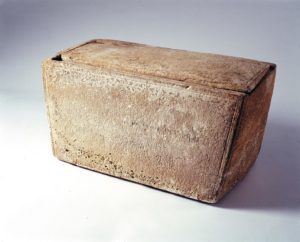
The James Ossuary. Paradiso, Wikimedia Commons
___________________________
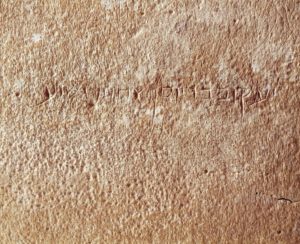
The key inscription detail on the James Ossuary, which reads James, son of Joseph, brother of Jesus. Paradiso, Wikimedia Commons
___________________________
Does this prove that this tomb is in fact the tomb of Jesus of Nazareth and his family?
Tabor qualifies his statements about the tomb. “We do not believe that statistics alone prove one way or the other that the Talpiot Jesus tomb is that of Jesus of Nazareth but the statistics do show that the oft-repeated assertion that lots of tombs in Jerusalem would likely have a similar set of names is false.”
But there is even more to this story…………
The Patio Tomb
Only one year after the initial discovery of the Garden Tomb, a dynamite blast, again associated with apartment complex construction work, exposed another ancient tomb only 60 meters north of the previously exposed Garden Tomb. Again, Amos Kloner was called in to investigate the tomb. He could enter the tomb only through a break in the ceiling. Its ancient square entrance was closed, sealed tight by a large “stopper” stone. What he first saw was a 3.5 by 3.5 meter rock-cut single square chamber. Cut into and along three of its sides were nine carved gabled burial niches, about 2 meters deep, three in each side. Each niche was sealed in front with a blocking stone. Kloner observed skeletal remains in the niches, with significant primary burial remains in four of them, meaning those skeletal remains had not yet been placed permanently into ossuaries. Also found were some cooking pots placed in three locations on the floor.
Kloner wasn’t afforded much time to examine the tomb. Soon, he was forced to leave the tomb by protesting ultra-Orthodox Jews, determined to protect the sanctity of the tomb. But this was not before he was able to acquire one smaller ossuary for examination—a decorated ossuary with no inscription, fit for the remains of a child. He entrusted it to the custody of IAA authorities at their Rockefeller headquarters (The ossuary is now part of the State of Israel collections).
Despite the protests, Kloner and the IAA were determined to investigate the find. Although he had to depart the country to fulfill another commitment, he entrusted two IAA archaeologists, the late Joseph Gath and Shlomo Gudovitch, to continue the investigation. Upon returning to the site, they were able to remove the blocking stones from the niches and examine ossuaries inside, a total of seven, taking photographs and recording their positions. All ossuaries but one were decorated and two were observed to have Greek inscriptions. They spent several days at the tomb location, removing the ossuaries from their niches and opening their lids for further examination. While preparing to raise the ossuaries up through the tomb ceiling to transport them to the IAA Rockefeller headquarters, they were again prevented from completing the task by a group of ultra-Orthodox Jewish protesters. The seven remaining ossuaries were returned to their niches, albeit not all in their original positions. There they remain to this day.
It was not until 2005, more than 25 years later, that a new archaeological team was assembled to take another look at the tomb (today known as the “Talpiot B” or “Patio” tomb) and its contents. This latest exploration and documentation was conducted by a team that included a mix of experts, including the well-known Canadian film producer and director Simcha Jacobovici, Tabor and noted archaeologist Rami Arav of the University of Nebraska, top Canadian film producer Felix Golubev, two key technical experts Walter Klassen and William Tarant, and Dr. James H. Charlesworth of Princeton Theological Seminary as an academic consultant. What prompted the new initiative was the proximity of the tomb to two other tombs, the first being the previously discovered Garden Tomb; and the second, a tomb mostly destroyed in 1980 by a dynamite blast during preparations for construction work.
“It was the proximity of these three tombs, and the possibility that they were clustered together on a wealthy estate in the 1st century CE that prompted us to request a permit to carry out further investigations,” reported Tabor in his Preliminary Report about the Patio Tomb exploration. The immediate vicinity of the three tombs also included the remains of a plastered ritual bath (or mikveh), water cisterns, and an ancient olive press. Joseph Gath, who surveyed the area, determined that they, including the tombs, belonged to a large, wealthy agricultural estate. They were likely the family tombs of the owner of the estate. “The object of our investigation was to determine whether the “patio” tomb, still intact, might contain names or other evidence that would provide for us further data that might conceivably shed light on the adjacent Garden Tomb with its intriguing cluster of names,” reported Tabor in the preliminary report.
But further exploration of the tomb now faced almost insurmountable hurdles, including the requirement by the Orthodox authorities that the tomb remains not be touched or disturbed, the challenge of obtaining permissions from several different sources, each of which had a different agenda and a different set of interests to consider and safeguard, and the extremely limited clearance space around the ossuaries within the burial niches of the tomb. What was necessary would be an unprecedented “hands-off” probe of the tomb contents. To accomplish this, the team came up with a unique robotic arm and camera/video assembly specially designed for the task.
The results, after painstaking efforts and mid-course adjustments, were nothing less than astonishing. In addition to the findings of Kloner’s initial investigation, the team was able to distinguish the details of four ossuaries with ornamental engravings, one plain ossuary, and two ossuaries with unique markings and inscriptions.
It was the latter two ossuaries, designated as ossuaries 5 and 6, that caused the stir. Ossuary 5 showed an ornamental front façade with twin rosettes and elaborate frieze border. Interestingly, between the rosettes was a four-line Greek inscription. The use of Greek would not necessarily be considered extraordinary. The translated text, however, reading as it were like an epitaph, was quite extraordinary under these circumstances. More unusual still was the use of the word for the name of God, Yahweh, written in Greek on a 1st century ossuary in what is clearly a tomb belonging to a Jewish family of the time, and words that expressed a raising up or resurrection (“rise up to God”, or “rise up to heaven”). Ossuary 6, originally (when explored by Kloner) in the first position closest to the tomb entrance, featured perhaps the most interesting markings. Its front showed what the team interpreted as the image of a fish, including tail, fins, and scales, with what appeared to be a stick-like human figure with a large head emerging from its mouth. Along the top border was a series of smaller, fish-shaped images. Incised on the left end was a bell-shaped circle that featured a cross inside. On the right end was an image that appeared to be a scaled body and tail of a fish, although only the lower portion of it is shown, upended. Within the head of the fish was inscribed what was interpreted to be the name “Jonah” — and it was this finding that Ossuary 6 became popularly known from this point forward as the “Jonah Ossuary”.
“Rise up to heaven”, a fish, an image emerging from the ‘mouth’ of the fish, and the name “Jonah”. So what did these findings mean?
The findings of Ossuary 5 and Ossuary 6 became perhaps the most sensational and most controversial discovery emerging from the tomb. This was, according to the investigative team interpretation, not only because they could be images of a fish, an animal, on a 1st century Jewish ossuary (something that would have been prohibited by 1st century Judaism), but because the imagery was similar to that seen within the 3rd and 4th century CE Christian tombs of the catacombs in Rome—the “sign of Jonah” (as in Jonah and the big fish, or whale, of the biblical account), images that are known to have symbolized the resurrection among early Christians. According to Tabor and colleagues, these could now be the earliest known archaeological finds related to the early followers of Jesus, or Christians.
Tabor’s interpretation has, needless to say, caused a firestorm of debate among scholars. Among them is Kloner himself, the initial IAA archaeologist who investigated the tomb upon its discovery, who now interprets the fish image on the Jonah ossuary not as a fish but as a funerary vase or amphora (joining a number of other scholars suggesting the same interpretation), and that the Greek inscription should not be interpreted to read as a ‘rising up’ or resurrection but actually as a warning expressing a prohibition against disturbing the bones of the tomb.
Slam-Dunk?
Notwithstanding its controversy, the peculiar Patio Tomb’s iconography and proximity to the Garden Tomb could be saying something else, says Tabor. It could be one more indicator that the Garden Tomb is, indeed, the tomb of the family of Jesus of Nazareth, and, not without great controversy, the final resting place of the body of Jesus himself, Mary his mother, Mary Magdalene — considered Jesus’ close companion by both the biblical canon and other ancient accounts — and a child who was the “son of Yeshua, or Jesus. And now James, son of Joseph and brother of Jesus.
When all the pieces are put together—the Garden (“Jesus Family”) Tomb, the Patio (“Resurrection”) Tomb, and the James ossuary, maintains Tabor and his colleagues, then the findings and interpretations make the identification of the Garden Tomb as the tomb of Jesus of Nazareth a “slam-dunk” case.
________________________________________
The apartment complex patio today, under which its namesake Patio Tomb (or ‘Resurrection Tomb’) is located. Like the Garden Tomb, it is now sealed off from entrance.
_________________________________________
View of niche with ossuary within the Patio Tomb, showing blocking stones. Photo credit: William Tarant, GE Inspection Technologies and Associated Producers, Ltd.
__________________________________________
Remote camera view of one of the tomb niches containing ossuaries. The team could see that maneuvering cameras within the spaces would be a challenge, to say the least. Photo credit: William Tarant, GE Inspection Technologies and Associated Producers, Ltd.
___________________________________________
The narrow gaps between the ossuaries and the walls of the niches presented a major problem for a camera probe. Photo credit: William Tarant, GE Inspection Technologies and Associated Producers, Ltd.
____________________________________________________
_____________________________________________________________
Above and below: Views of the inscribed images discovered on the “Jonah Ossuary”, made possible through the robotic arm camera system devised by the team engineers. Photo credit: William Tarant, GE Inspection Technologies and Associated Producers, Ltd.
________________________________________________________________
Closeup view of ossuary 6 with YONAH inscription highlighted. Background photo credit: William Tarant, GE Inspection Technologies and Associated Producers, Ltd.
——————————————————————-
Article Supplement 6
The Lost Primacy of James the Just
The discovery of the James Ossuary and its original provenance in the Garden Tomb has served to support and draw attention to an overlooked or, as Tabor would suggest, historically suppressed, point about the man James (otherwise known as ‘James the Just’), the brother of Jesus who was also an Apostle and a major player in the very earliest movement of the followers of Jesus.
James, considered a significant figure associated with Jesus in the Apostolic period, was recorded by Josephus to have died in 62 CE, having been first hurled from the top of Jerusalem’s southeastern Old City wall by his adversaries and then bludgeoned to death after having barely survived the fall into the Kidron Valley below. He has often been referred to as ‘James the Just’, or James, brother of Jesus. Not to be confused with James, son of Zebedee, another apostle, Roman Catholic tradition holds that he was James, son of Alphaeus, or ‘James the Less’. Tabor argues that James was likely Jesus’ “beloved disciple” referred to in the gospel accounts, facilitated in no small measure by his close familial relationship with Jesus (“nursed with the same milk,” as recorded in the Second Apocalypse of James).
“Although Peter is [traditionally] remembered as the titular leader of the apostles, our earliest New Testament sources tell a somewhat different story,” writes Tabor. He points to the Acts of the Apostles, for example, as making reference in several places to the primacy of James’ leadership. And he refers to other sources, such as Eusebius and the testimony of Hegesippus (a Jewish Christian of the early second century CE), as well as the Gospel of Thomas, the famous manuscript found among the Coptic texts in the Nag Hammadi library. “Although the Gospel of Thomas dates to the third century,” writes Tabor, “scholars have shown that it preserves, despite later theological embellishments, an original Aramaic document that comes to us from the early days of the Jerusalem church. It……provides us with our clearest evidence that James succeeded Jesus as leader of the movement.”
Tabor asserts that James was systematically, over time, written out or downplayed in the evolving Rome-centered Christian theology’s emphasis on Peter as the apostle through whom the ‘keys of the kingdom’ were to pass and to whom ecclesiastical authority was to be traced after Jesus.
——————————————————————-
Article Supplement 7
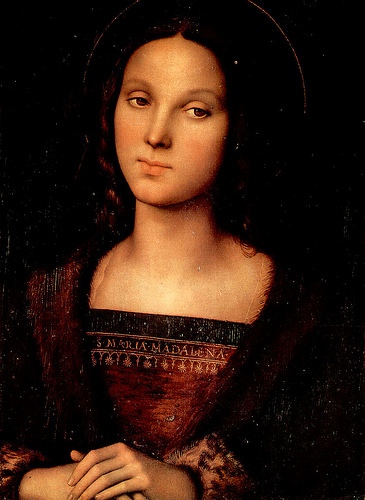
Mary Magdalene — The Companion of Jesus?
Dan Brown’s popular novel, The Da Vinci Code, tells the sensational story revolving around the notion that Mary Magdalene was the wife of Jesus, giving birth to his child and thus leaving a legacy of physical ‘heirs’ to his lineage. A false and unthinkable circumstance, according to many scholars and certainly according to most theologians. There is little disputing, however, that she is considered one of Jesus’ inner circle of followers. It is clear from the canonized gospel accounts.
But a closer and broader examination of ancient writings could be depicting a significantly different portrait of the woman who, next to his mother Mary, figured so prominently in Jesus’ life — one that may not be too far removed from the fictional image so portrayed of Mary Magdalene in the Dan Brown book. Tabor writes about it in his blog and in his books, drawing from a variety of ancient texts, included among them the Coptic text of The Gospel of Mary and The Gospel of Philip. They describe a Mary who is closer to him than any of the other apostles, privy to his thoughts, and even his intimate companion, as would be typically ascribed to a wife:
“Peter saying to Mary: “Sister, we know the savior loved you more than any other woman. Tell us the words of the savior that you remember, which you know but we do not, because we have not heard them.” Mary answered and said, “What is hidden from you I shall reveal to you.” (Gospel of Mary)
“The companion of the [savior] is Mary Magdalene. The [savior loved] her more than [all] the disciples, [and he] kissed her often on her [mouth]. The other [disciples] said to him, Why do you love her more than all of us?” (Gospel of Philip)
“Taken together, these texts [to which he refers to a number of texts in addition to the gospels of Mary and Philip]…….provide us with a broader context in which the evidence from the Talpiot tombs can be read in a new light,” writes Tabor.
By ‘evidence from the Talpiot tombs’ Tabor refers mostly to the Talpiot Garden Tomb which contained, according to him, an ossuary with an inscription identifying Mary Magdalene — an ossuary that contained ancient bone residue which, based on scientific DNA analysis, revealed a person interred in the tomb who bore no blood relationship to the person whose bone residue was found in the Jesus, Son of Joseph ossuary.
It brings us to the question: Was Mary Magdalene the wife of Jesus?
Given that no blood connection likely meant a family member through the relationship of marriage, based on what is known about the remains of individuals in ancient 1st century CE Jewish tombs, one has to consider the possibility, according to Tabor. And it would have been natural for a rabbi of the time, which Jesus was, to be married and the head of a family, he adds. He maintains that the ascetic concept of celibacy was introduced by church fathers interpreting the writings of Paul in later centuries, becoming a part of the accepted doctrine governing the behavior and circumstances of ecclesiastical authorities.
—————————————————
A Continuing Quest
Tabor’s quest to uncover the historical truth about Jesus has not ended with the tombs. His research into the ancient writings, both canonized and otherwise, lie at the core of his endeavors. However, equally significant for him are the onging archaeological investigations into the places and artifacts that could bear on the historicity of Jesus’ life and times. His co-directorship of the Mount Zion excavations in Jerusalem, where he and co-director archaeologist Shimon Gibson have been excavating for several seasons, has, and he hopes will continue to, shed additional new light on the lifeways and circumstances of members of the Jerusalem power elite during the crucial last days of Jesus, filling in new details in the backdrop that framed the events of his trial, death and its aftermath. He plans to conduct archaeological excavations in the area beneath the Armenian parking lot that lies on the other side of the Turkish Old City wall, adjacent to his suggested judgment seat of Pilate, where he suspects remains of the Roman Praetorium still lie buried. And there is still the future potential for conducting further DNA testing on any osteological/organic traces that may still exist within the interior porous limestone walls of the Garden Tomb ossuaries—leading, for example, to clarification of the relationship of the subject who was interred in the Judah son of Jesus ossuary to those who were interred in the Jesus son of Joseph and Maramene Mara (‘Mary Magdalene’) ossuaries.
Given the sensitivity that surrounds any findings and scientific claims related to the historicity of Jesus of Nazareth, however, Tabor makes clear that his research does not discredit or destroy faith. Indeed, anyone who spends time with Tabor would clearly see that there is a man of deep faith behind the practicing scientist/historian. It can be seen particularly in how he personally views Jesus.
“I see the main focus of Jesus’ message summarized best in the prayer he taught,” he says: ‘Let your Kingdom come, let your will be done, on earth as it is in heaven.’ Jesus focused on the proclamation of the Kingdom of God, which he declared was at hand! This means more than just a future apocalyptic “end of the age,” as he makes clear, but a present transformation of all areas of human society toward justice and righteousness.”
————————————————————–
_____________________________________________________
In addition to accompanying him throughout the ‘Holy Land’ and Jerusalem, Popular Archaeology interviewed Tabor. Below are his responses to some key questions related to his work. (Pictured left: Tabor looks on near the remains of the judgment seat of Pilate)
The Talpiot Tombs
Q: What in your mind is the most significant contribution or impact of the Jesus family (Talpiot A) tomb discovery on the scholarly quest to understand the historical Jesus and early Christianity? Why is this important?
A: There are several important contributions. If the Talpiot A tomb is truly the family tomb of Jesus of Nazareth, along with the “James ossuary” that we now believe was also removed from this tomb, this would give us the first direct material archaeological link to Jesus himself—not to mention his family. Further, that we would find the bones of Jesus preserved in an ossuary helps to advance our understanding of the nature of the earliest Christian faith in resurrection as expounded by Paul. The physical body, as Paul says, is shuffled off like old clothing, and the “naked” soul is then reclothed with a new spiritual body (2 Corinthians 5:1-10). This serves to reinforce for us that the earliest Christian faith in Jesus’ resurrection was not simply the resuscitation of his corpse, but a transformation into a new spiritual body, with the old “clothing” left behind. Finally, we learn from this tomb that Jesus was married and had at least one son—Judah, something our theologically oriented gospels, written decades after the destruction of Jerusalem in 70 CE, would not preserve or choose to mention in the interest of an emphasis on Jesus’ heavenly origins and divinity.
Q: Do you have any reason to suspect or suggest that there may be more tombs with features/finds of similar import to be found in the area of the Talpiot tombs?
A: There is a third tomb in the area but unfortunately it was destroyed completely in 1980 by the building blasts at the time. What we could eventually do is actually enter the “Patio” tomb, just 60 meters from the Jesus tomb, and examine in great detail all the evidence, especially settling some of the questions regarding the inscribed ossuaries and what they mean.
The Mount Zion Excavation
Q: Are there any significant finds, or potentially significant finds related to the Mount Zion excavations, that you think should be mentioned, but have not been mentioned or covered adequately thus far in the popular press?
A: I think the main thing is that this area of the city in the time of Jesus was a priestly “district” or Quarter—running up the slope to the top of Mt Zion, and we know that Caiaphus and other priestly families lived in this exclusive area. That Jesus has connections through the patron that owned the “Upper Room” house [the scene of the ‘Last Supper] at the top tells us that he did move in a wide variety of circles. It helps to explain how Joseph of Arimathea and Nicodemus, both members of the Jewish Sanhedrin, would have been sympathetic followers of Jesus.
General
Q: Are there any other comments or observations you would like to make related to the historical Jesus and John the Baptizer?
A: I believe it is important to see the two of them as a powerful team, united in purpose and cause, with John given his proper role as “greater” than any of those born of women. He went before Jesus but was his Teacher and inspiration. Later Christian theology totally reverses this by marginalizing John and exalting Jesus as the preexistent God in the flesh. This is totally alien to things as they were and act as a barrier to appreciating these two towering figures in terms of what they truly stood for.
Q: Given the controversial and sensitive nature of some of the hypotheses and suggestions that you have advanced about the historical Jesus, what has given you the courage to continue to speak out in defense of your views and findings?
A: I don’t in fact find any of the things I have suggested as properly “controversial” or “sensitive.” I am simply trying to see Jesus in a realistic way—as he actually was—rather than through the veil of Christian theology. He was a Jew, not a Christian and he knew nothing of the theological propositions that came to be propagated in his name. In fact I think he would be quite horrified at the whole transformation.
Q: When your life and work is finished, what would be the personal legacy you hope to leave in our understanding of the historical Jesus?
A: That Jesus was the man in whom God was well pleased and who unleashed a movement that centered on seeing the “will of God done on earth as it is in heaven”—still inspiring millions with his program and his cause.
——————————————————————-
Not all of Tabor’s suggestions about the historical Jesus have been covered within the limitations of this article. However, more detailed information about the results of Dr. Tabor’s decades of research can be obtained from his books, The Jesus Dynasty, and The Jesus Discovery, both published by Simon and Schuster. Also of interest would be Tabor’s blog, which is updated frequently with new posts.
—Ed.
Unless otherwise noted, all images courtesy of the author.
Cover Image, Top Left: 4222320, Pixabay
The views and statements published in this article are not necessarily the expressed views of Popular Archaeology Magazine or any writers affiliated with this publication.
___________________________________________________________
Subscribe to Popular Archaeology Premium. Available on all laptops and mobile devices, and still the industry’s best value at only $9.00 annually.
___________________________________________
Travel and learn with Far Horizons.
____________________________________________


